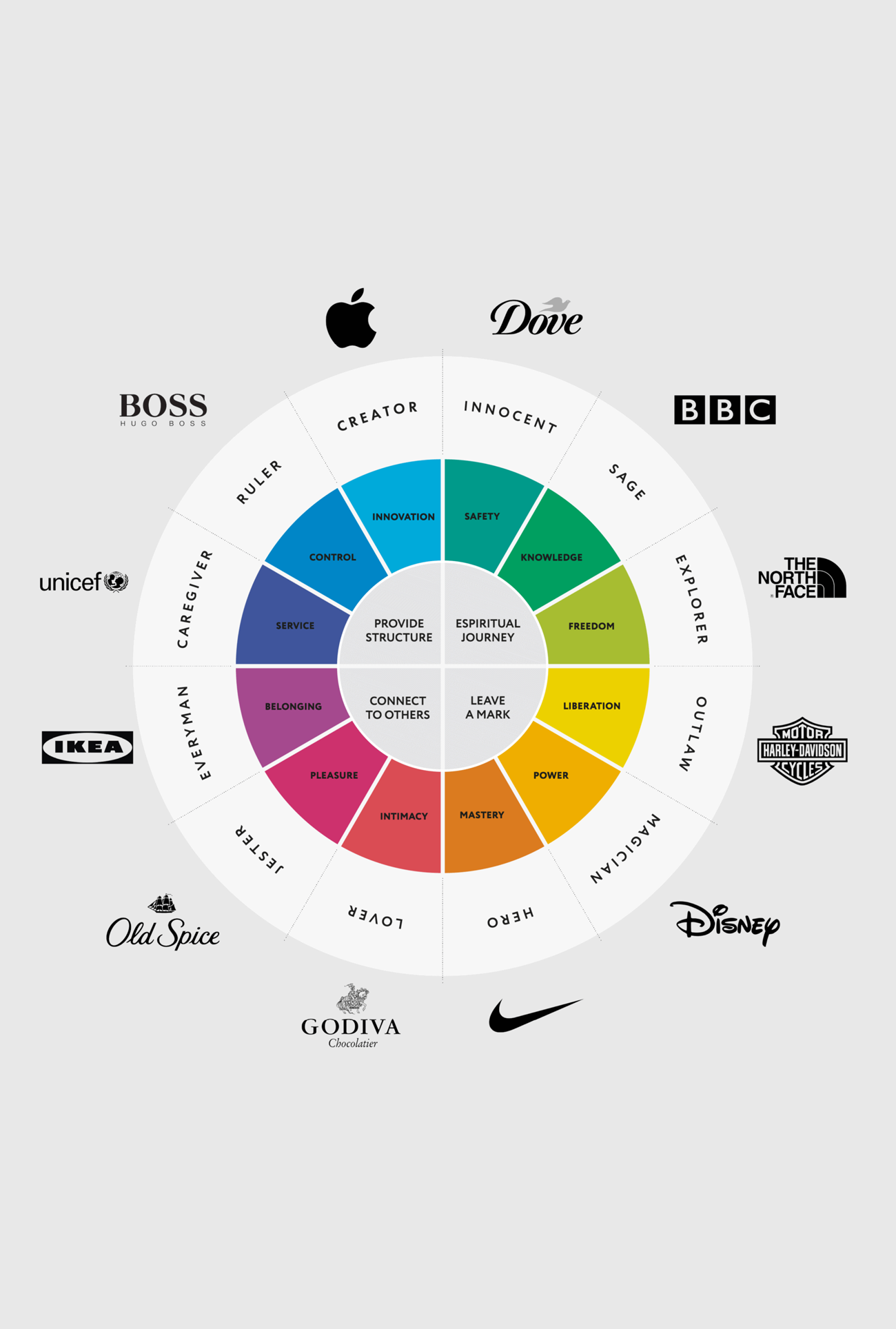
Another marketing buzzword? No it’s not, it’s actually a very important element in brand building. It’s actually something that you do when you create a brand story, may I dare say that it’s something that you do when you create a brand identity. This should be done before the logo is designed. This needs to be done when the brand is created.
When we speak about brands a lot of times we share examples from massive brands like Nike, Apple, Disney, Red Bull, Innocent, Harley Davison and others because they are easy to understand. But did you ever think why they are easier to understand? Well because we are familiar with them and we know what they ‘sound’ like. We are familiar with them because they are more ‘human’ and it’s easier to relate with them.
The reason why we know how they sound is because they’ve used this thing called Brand Archetypes and we can relate to them in some way, even if we can’t relate to one specific brand we can understand their personality, we can understand what they are like. We know that brand X has this type of personality. Like we know our Uncle Jamie is the guy that tells dad jokes at a dinner table all the time.
If a brand wants to connect with its customers, and audiences in a deep and meaningful way they need to build loyalty, and in order to build loyalty we need to be authentic. Brand archetypes can help us create a framework based on human psychology to help our company build an emotional connection with the audience.
I’m not a history guy but it’s important to know a bit about how it was created. Who invented archetypes? In the 1940s, a psychologist from Switzerland named Carl Jung developed a set of common personality archetypes.
He believed these were innate and hereditary, representing a model image of a person that transcends language, culture and time. As individuals, we can all inherently recognise and relate to the archetypes. They play a role in influencing our behaviour on a subconscious level, leading to typical behavioural patterns, desires, values and motivations all driven by a single dominant goal.
The primary Jungian archetypes are Self, Anima, Animus, Shadow, Persona, Father, Mother, Child, Wise Old, Hero, Trickster and Maiden.
These are not Personas as some might think, they are Brand Archetypes.
There’s just something about the brands we connect with on a human level. I talk a lot about emotional connection and I always talk about brand storytelling, but when we create a brand story we need to consider brand archetypes as well.
We have an affinity with them that’s hard to put your finger on. It’s as if we know them. In some cases, it’s as if we love them.
All brands are businesses and they all sell something; it can be an experience or it can be a product. We have a transactional relationship with brands(they give you something in exchange for your money), for some brands, we feel connection, loyalty and in some cases love. The last part is hard to achieve because it takes time, energy, dedication and of course great storytelling.
We have to remember that we all have basic human desires. We aren’t taught to want or need them. We just do.
They are instinctive and primitive. I’m sure you can relate.
Here are the basic human desires that each match with a specific archetype;
- LIBERATION > THE OUTLAW
- POWER > THE MAGICIAN
- MASTERY > THE HERO
- INTIMACY > THE LOVER
- ENJOYMENT > THE JESTER
- BELONGING > THE EVERYMAN
- SERVICE > THE CAREGIVER
- CONTROL > THE RULER
- INNOVATION > THE CREATOR
- SAFETY > THE INNOCENT
- UNDERSTANDING > THE SAGE
- FREEDOM > THE EXPLORER
So what are the 12 brand archetypes?
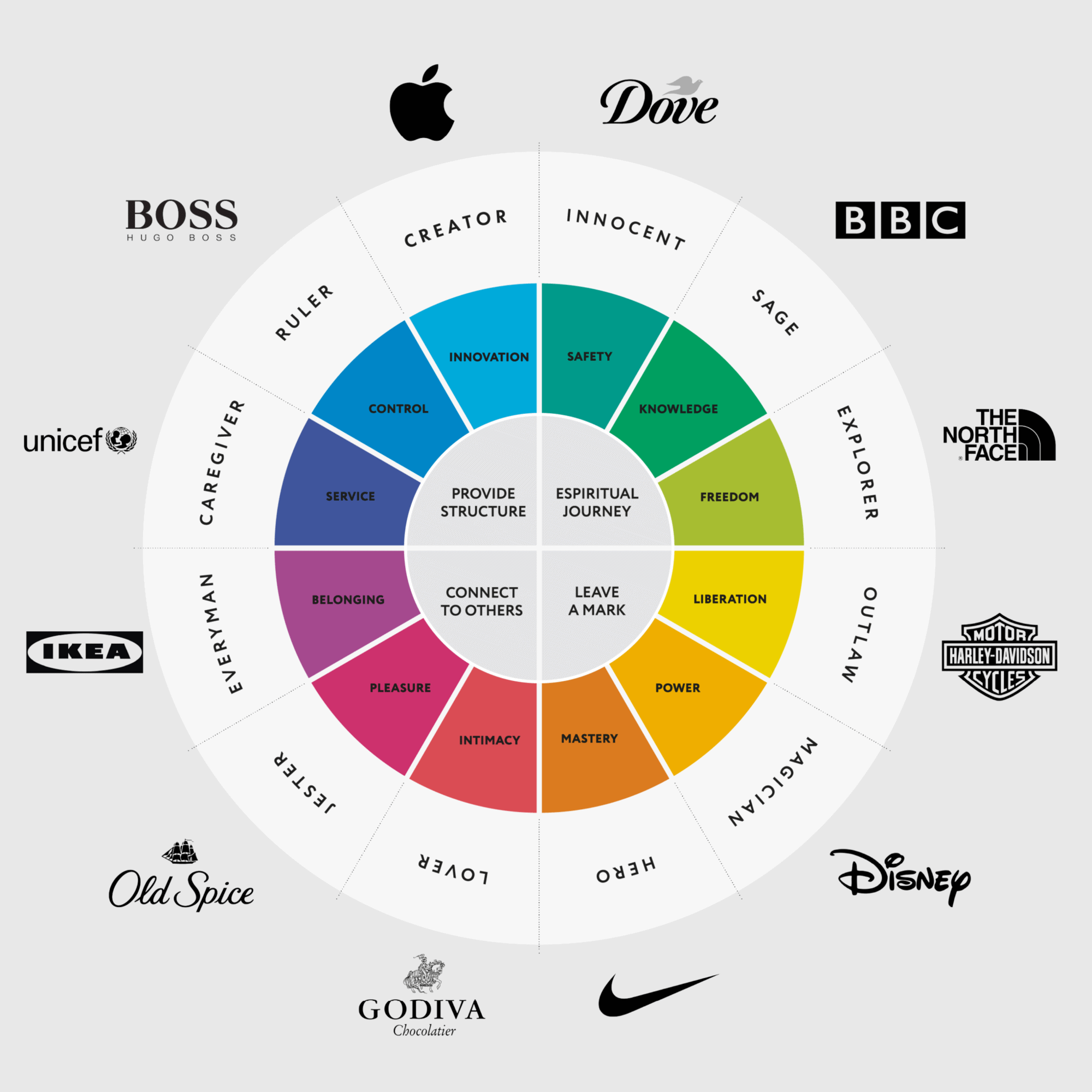
Let’s dive into them in a deeper way. All images below are from iconicfox.com.au
The Outlaw Archetype
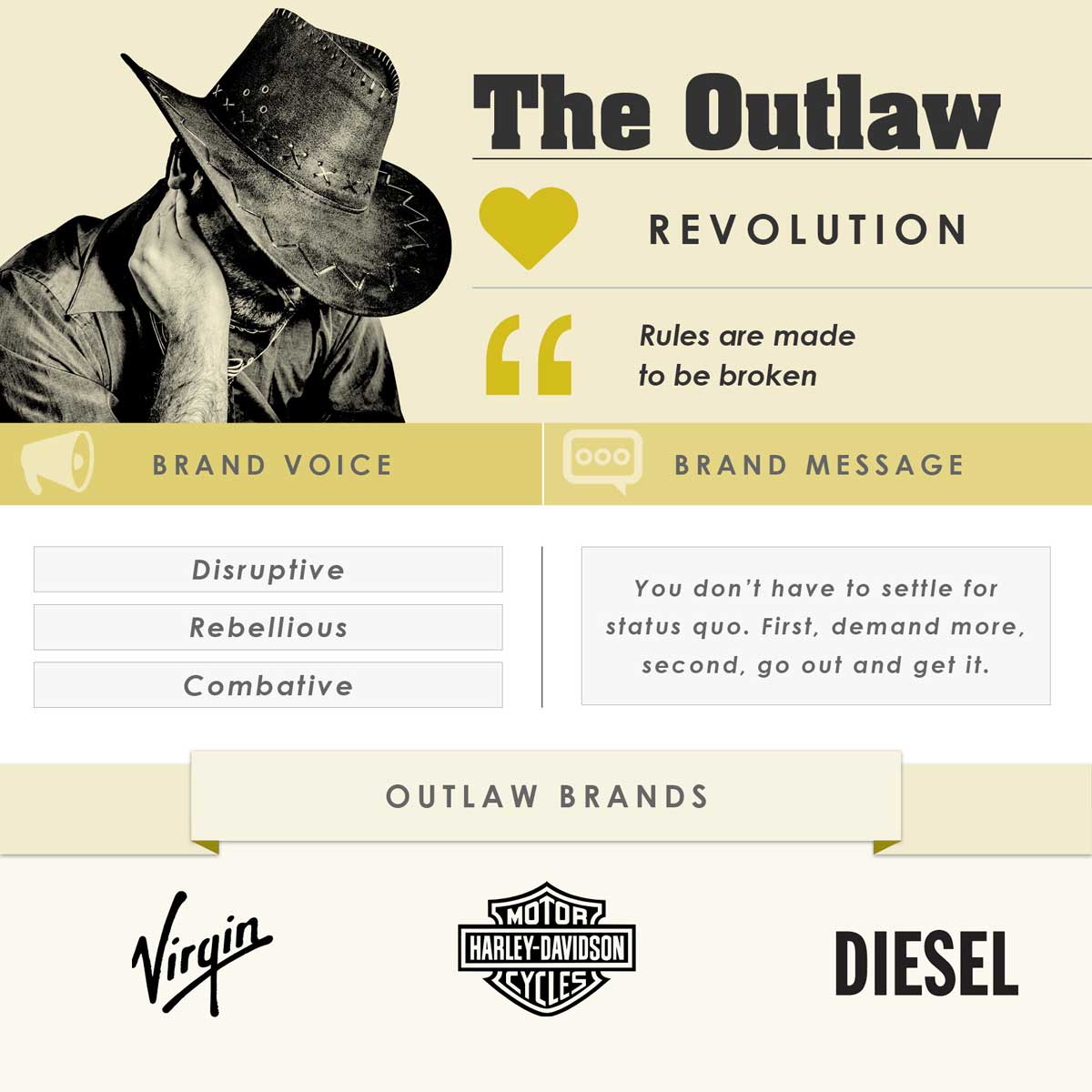
The Outlaw has a desire for revolution partly to change the world for the better and partly for the anarchy involved. They have a disdain for rules, regulation and conformity that would remove any form of their freedom of choice (or anyone else’s). They are good at the core but anger is part of their motivation, which can become the dominant force. Without a fight, they are lost.
Common Industries: Automobile (Motorcycles), Alternative Apparel, Destruction Tools, Body Art
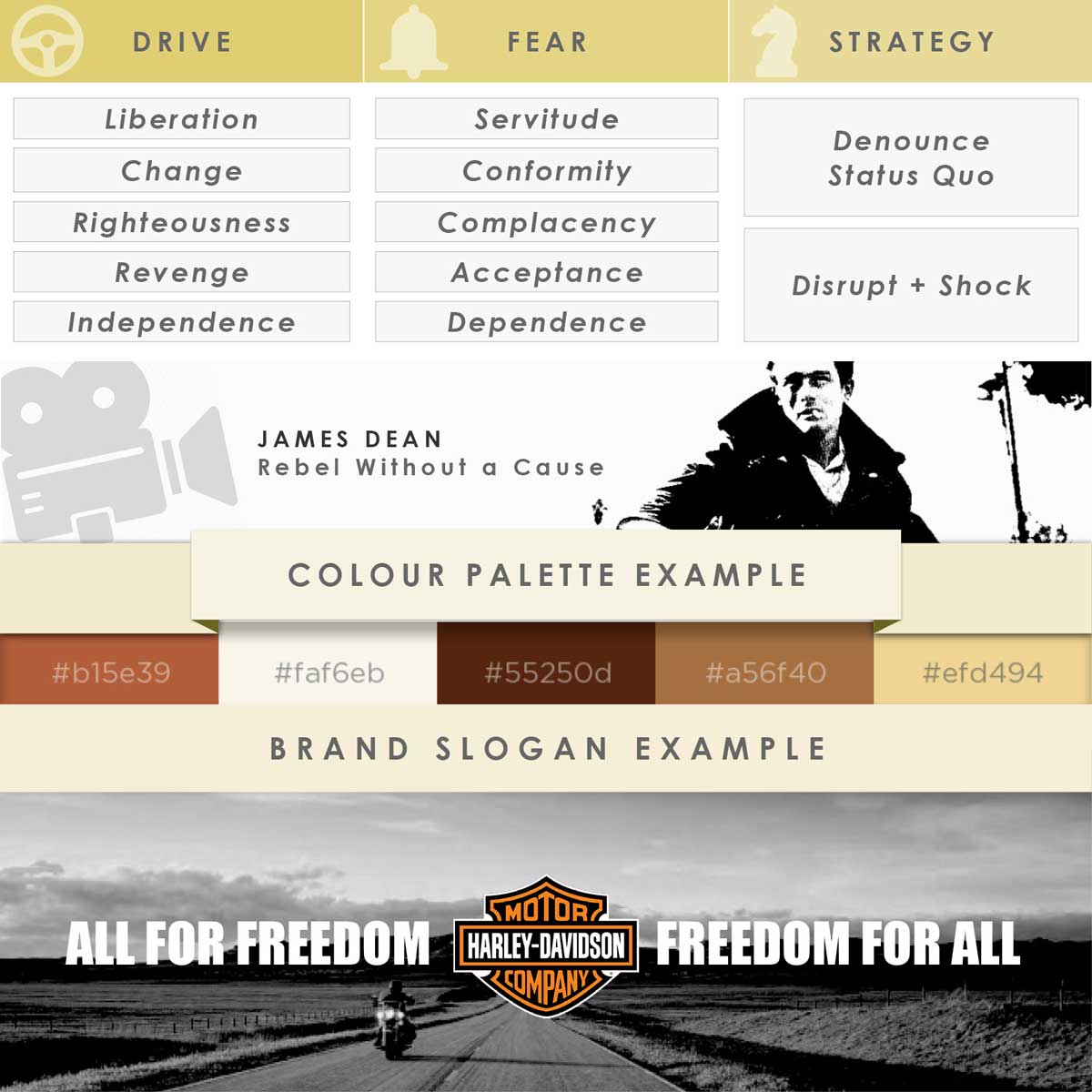
The Outlaw Brand In Action – Harley Davidson
The Magician Archetype
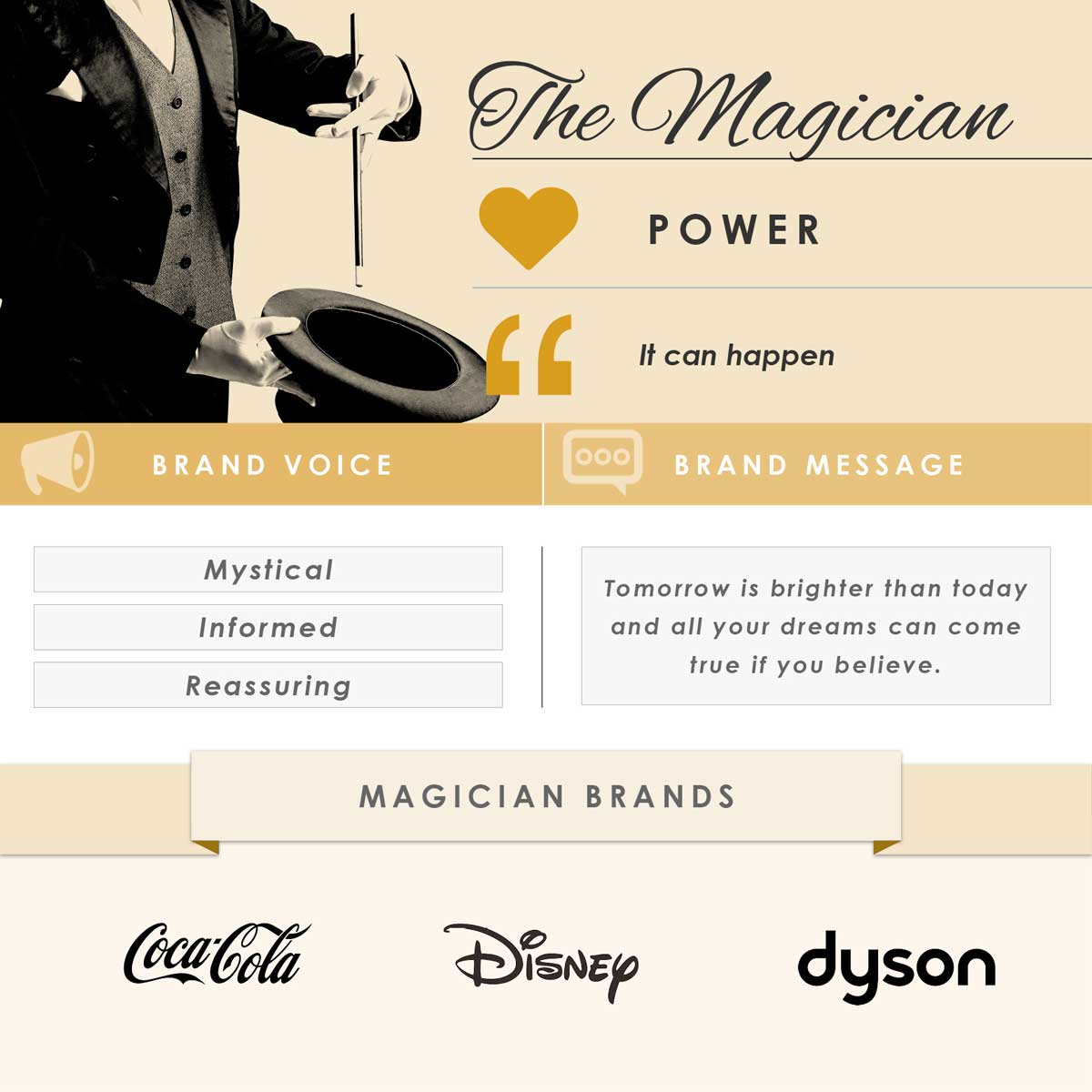
The Magician Personality
The Magician strives to make dreams come true through somewhat mystical ways. They have the ability to take people on a journey of transformation through the experience of a magical moment. They believe that we are limited only by imagination and defy the common belief of the laws of reality to lead us to a better future. Magicians have a thirst for knowledge though they don’t willingly share it, rather they use it to show their vision.
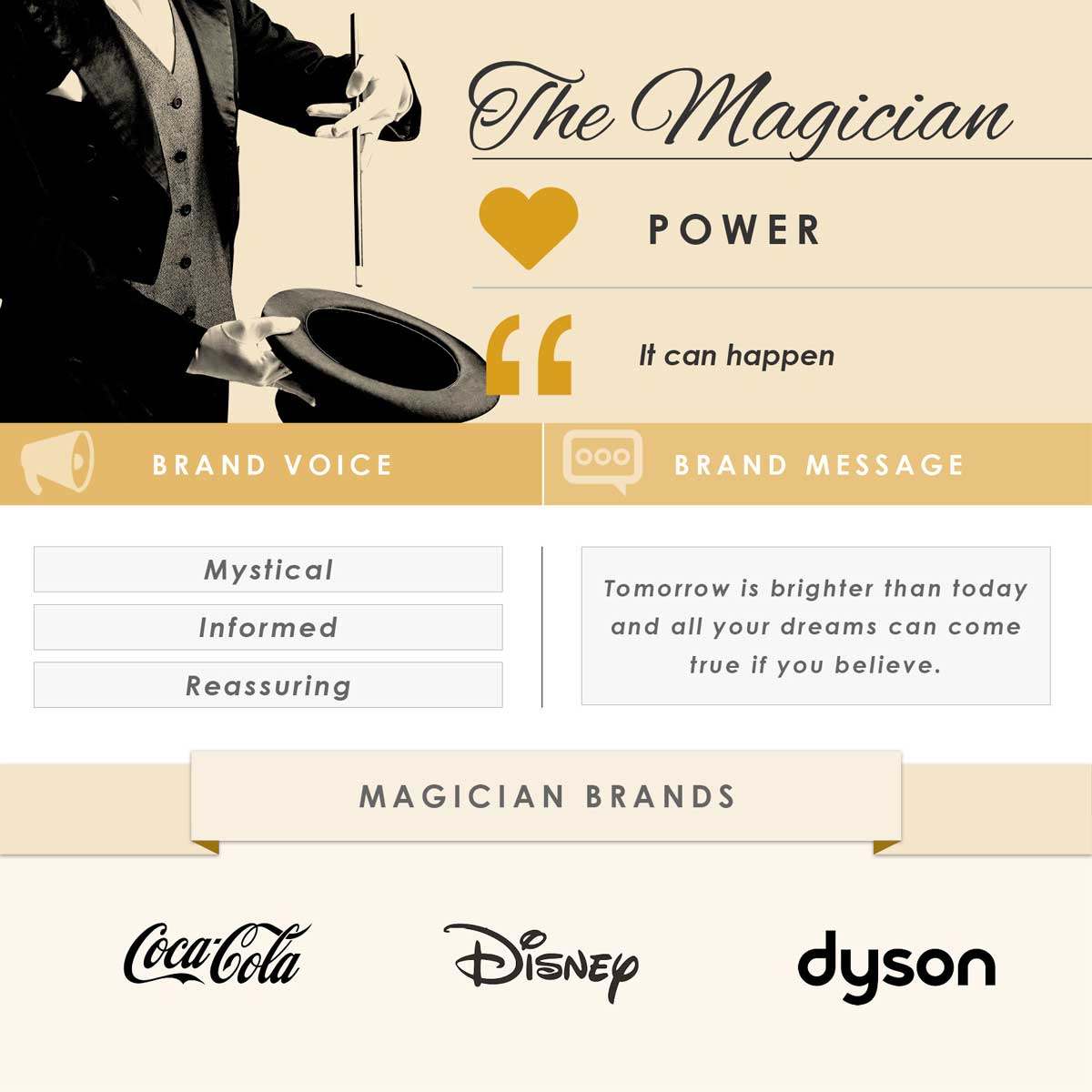
The Magician Branding Strategy
The Magician archetype rarely fits a buyer persona but appeals to different personas with their ability to transform. Brands that provide a product or service that take their customers on a transformational journey (Lost to found, Insecurity to security, Worn out to refreshed), could well consider the Magician Archetype as the personality to connect with their audience.
Common Industries: Health, Beauty, Relaxation / Well-Being, Entertainment
The Magician Brand In Action – Disney
The Hero Archetype
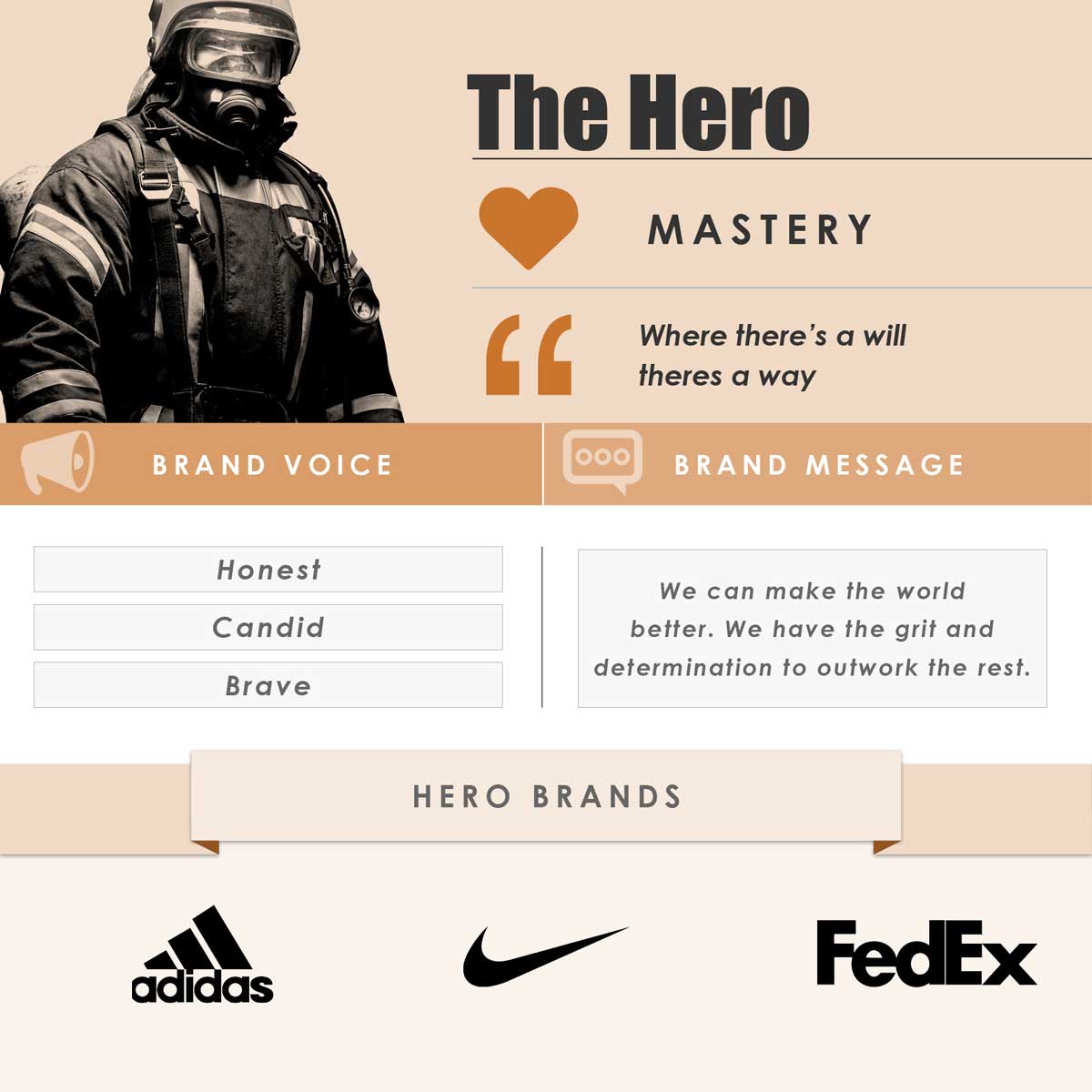
The Hero Personality
The Hero’s main motivation is to prove their worth through courage and determination.
They work hard in order to have the skills they deem requirements and take pride that their work rate sets them apart from the rest.
They need to meet challenges head-on and carry defeats or failures until they are corrected.
The Hero wants to save the day to prove their worth to themselves but also so the world knows of their ability.
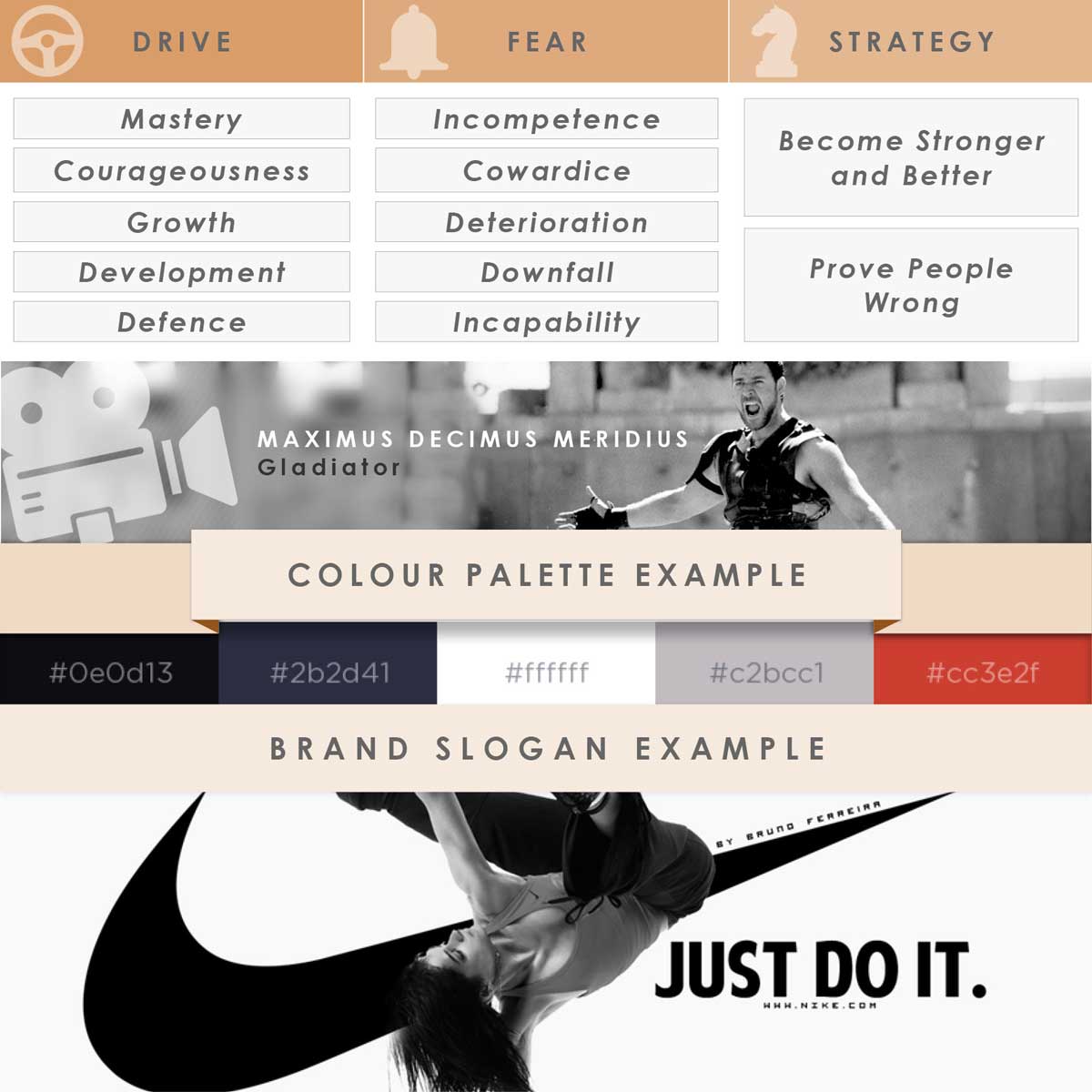
The Hero Branding Strategy
To appeal to a hero you should inspire them and make them feel empowered to succeed and achieve.
They see themselves as upstanding citizens and the bully’s nemesis and they stand up for what’s right.
Hero’s want to rise to their ambitions and brands that can acknowledge those ambitions and encourage the challenge will connect with them.
A Hero wants to be inspired by the possibility to achieve and gratification that comes with it.
Common Industries: Sportswear, Sports Equipment, Outdoor / Tactical Equipment, Emergency Trade Services (Plumbing, Electricity, Locksmiths, Mechanic)
The Lover Archetype
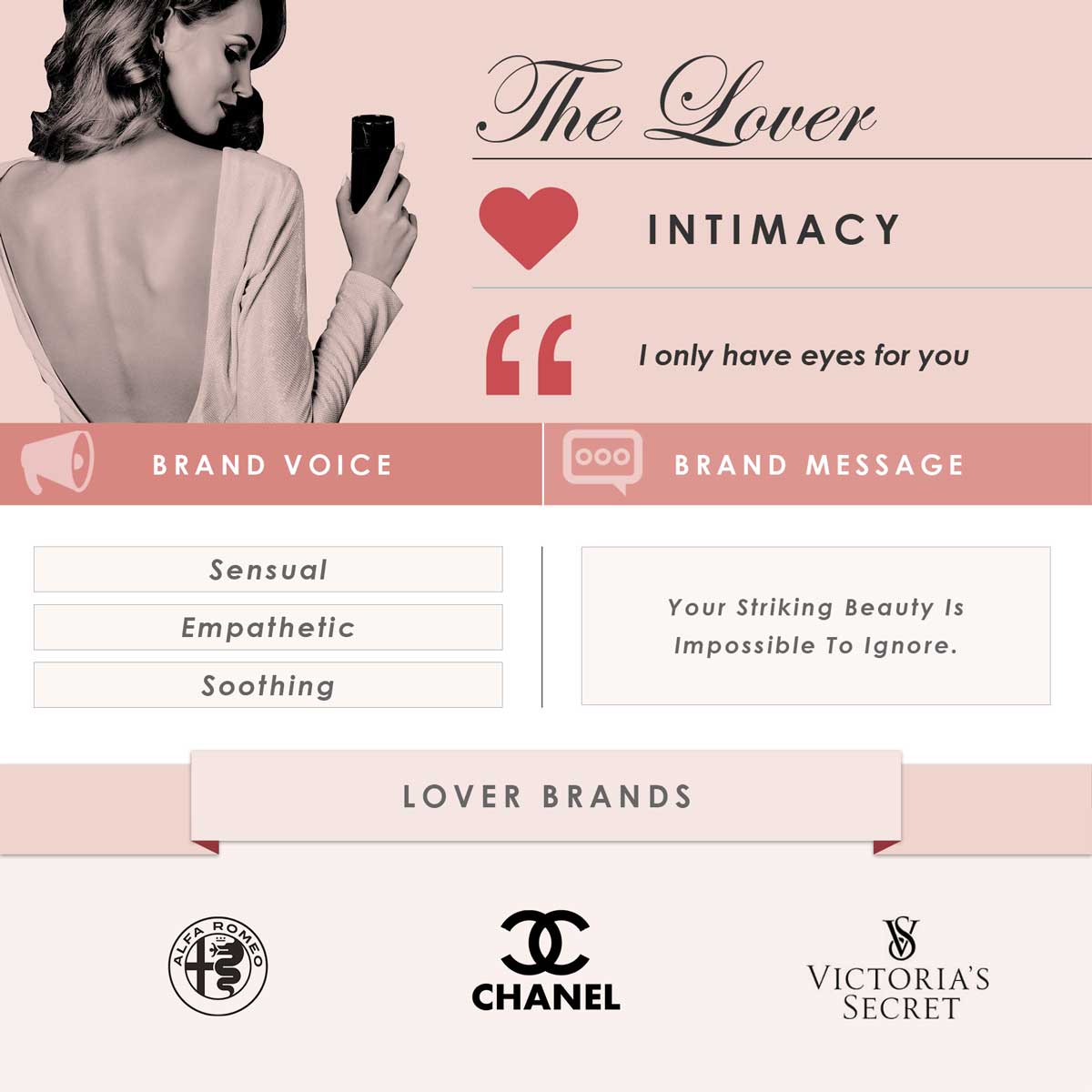
The Lover Personality
The lover desires to be desired. The experience of Intimacy, closeness and sensual pleasure are what the lover seeks and will use the means they have to achieve it. They are motivated to become more physically and emotionally appealing to increase their capacity to attract others.
They fear being unnoticed, unloved and unwanted and because their passionate desires cloud their judgement, they can easily be misled. Even when Lovers achieve all their desires, they are still fearful of loss.
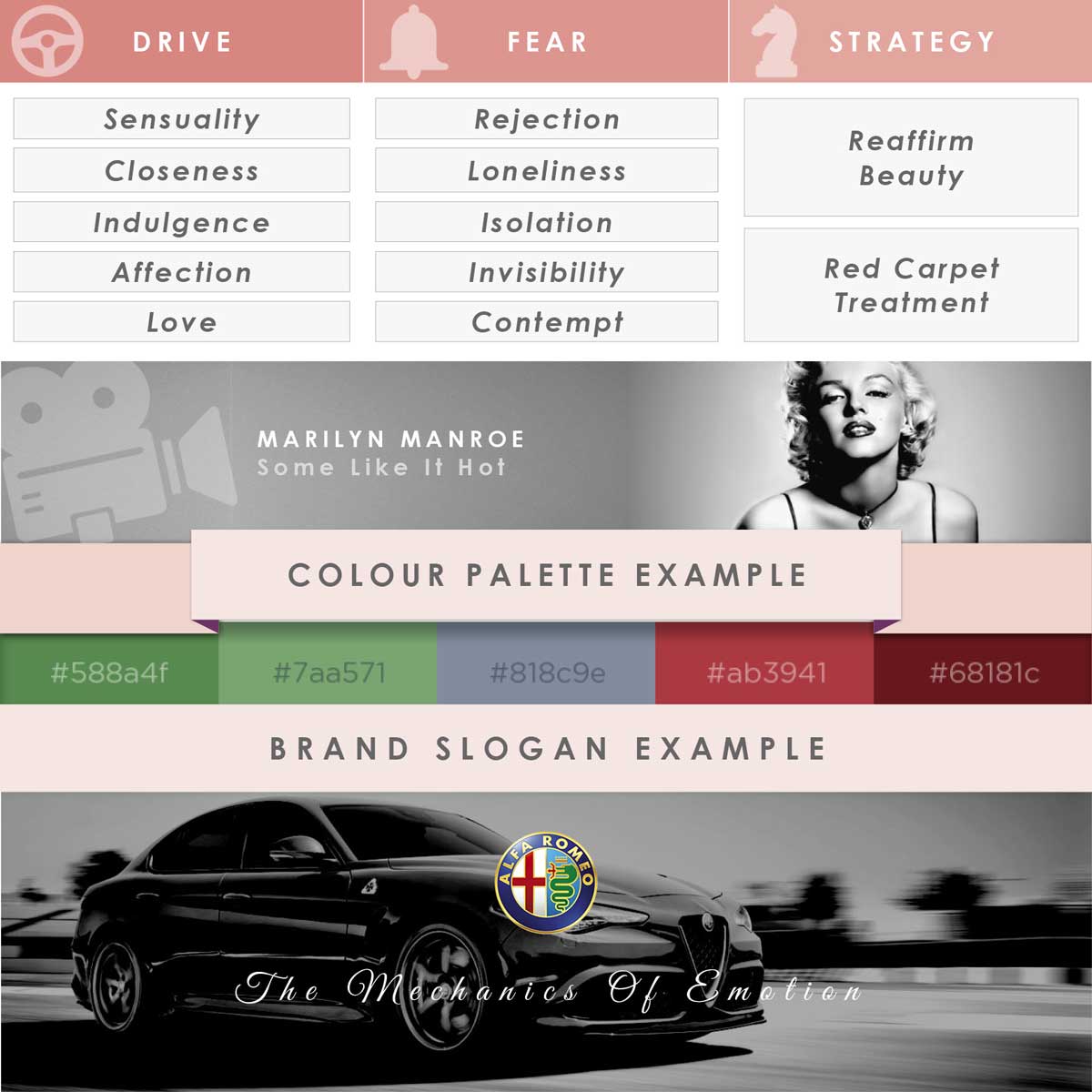
The Lover Branding Strategy
To appeal to a Lover you need to make them feel attractive or stir their passionate desires for connection and intimacy. Because of their attraction to sensory pleasure, communication and messaging should use sensual language and tone. Imagery and tone of voice are especially important for The Lover archetype.
Brands appealing to Lover personalities can leverage their audiences desire for sensual pleasure through sight, sound, smell or touch. The colour red is especially appealing to The Lover.
Common Industries: Cosmetic, Fragrance, Indulgent Food, Indulgent Travel, Wine
The Lover Brand In Action – Alfa Romeo
The Jester Archetype
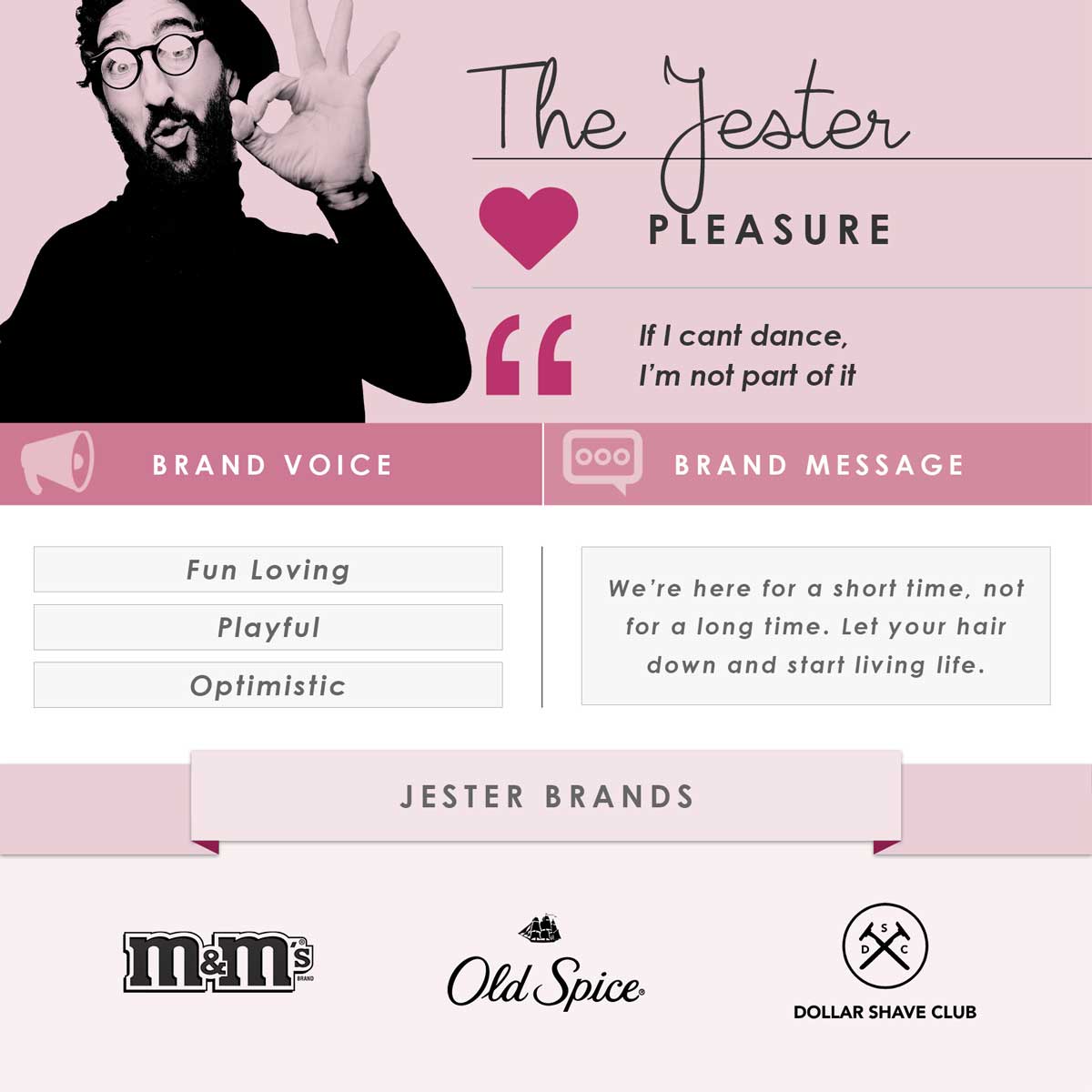
The Jester Personality
The Jester is all about having fun and living life in the moment. They not only love having fun themselves, they see it as their duty to be a ray of sunshine in everyone’s life around them.
They are optimists and can’t be kept down long due to their ability to see the good in every situation. Jesters are young at heart and continue their child-like nature long after their friends have grown up and become serious.
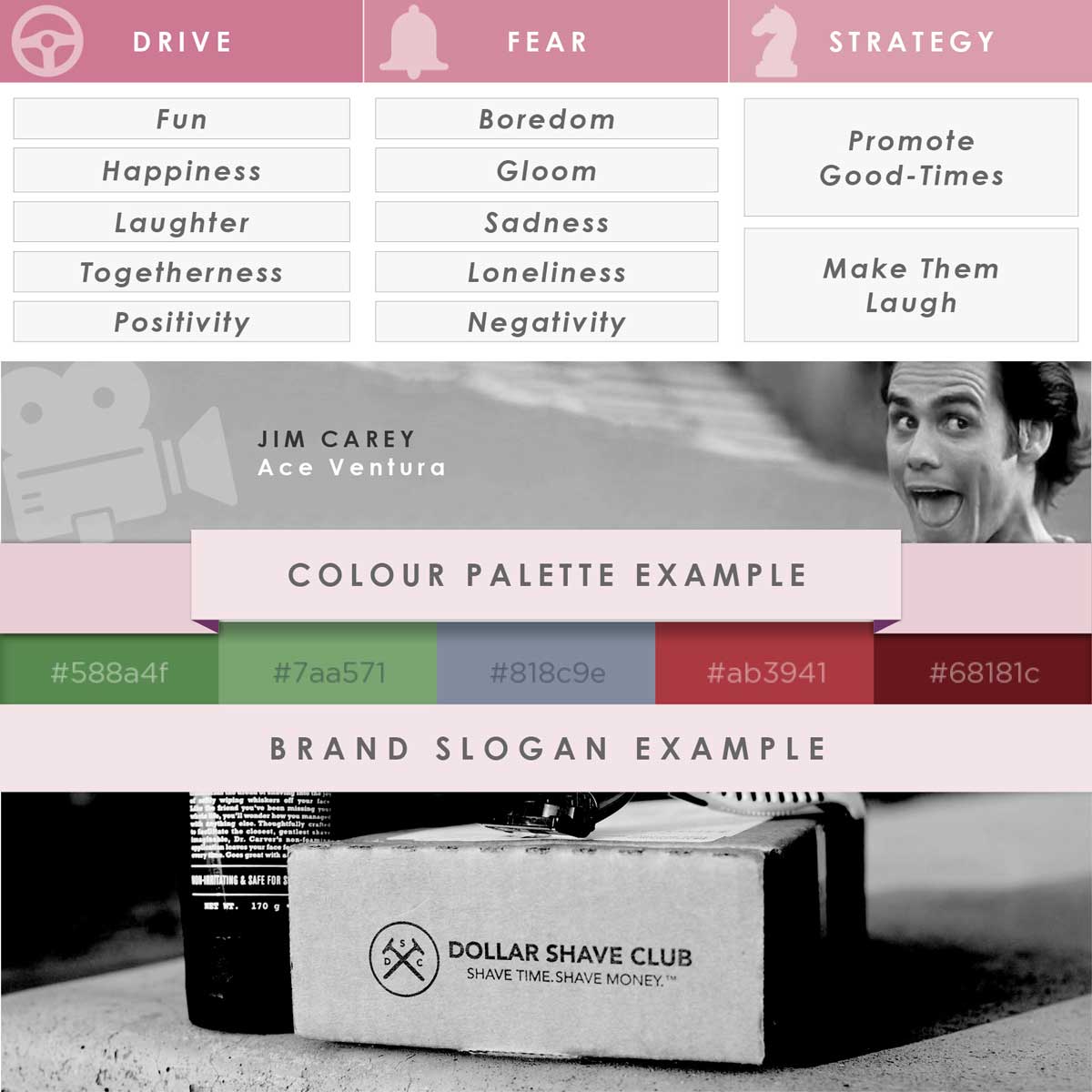
The Jester Branding Strategy
Like Magicians, Jesters are rarely a buyer persona but can be a perfect archetype for brands in the business of entertaining or wanting to associate themselves with good times.
Regardless of archetype and personality, everyone likes to laugh and provided the context and the timing is right, the Jester personality can be a memorable and loving point of differentiation.
As the Jester Archetype your brand should highlight the light-hearted and positive side of life with a playful and entertaining spirit. Brands that are able to connect with their audience through happiness and laughter can become much-loved brands.
Common Industries: Confectionary, Beer/Lager, Child Services, Professional Services
The Jester Brand In Action – Dollar Shave Club
The Everyman Archetype
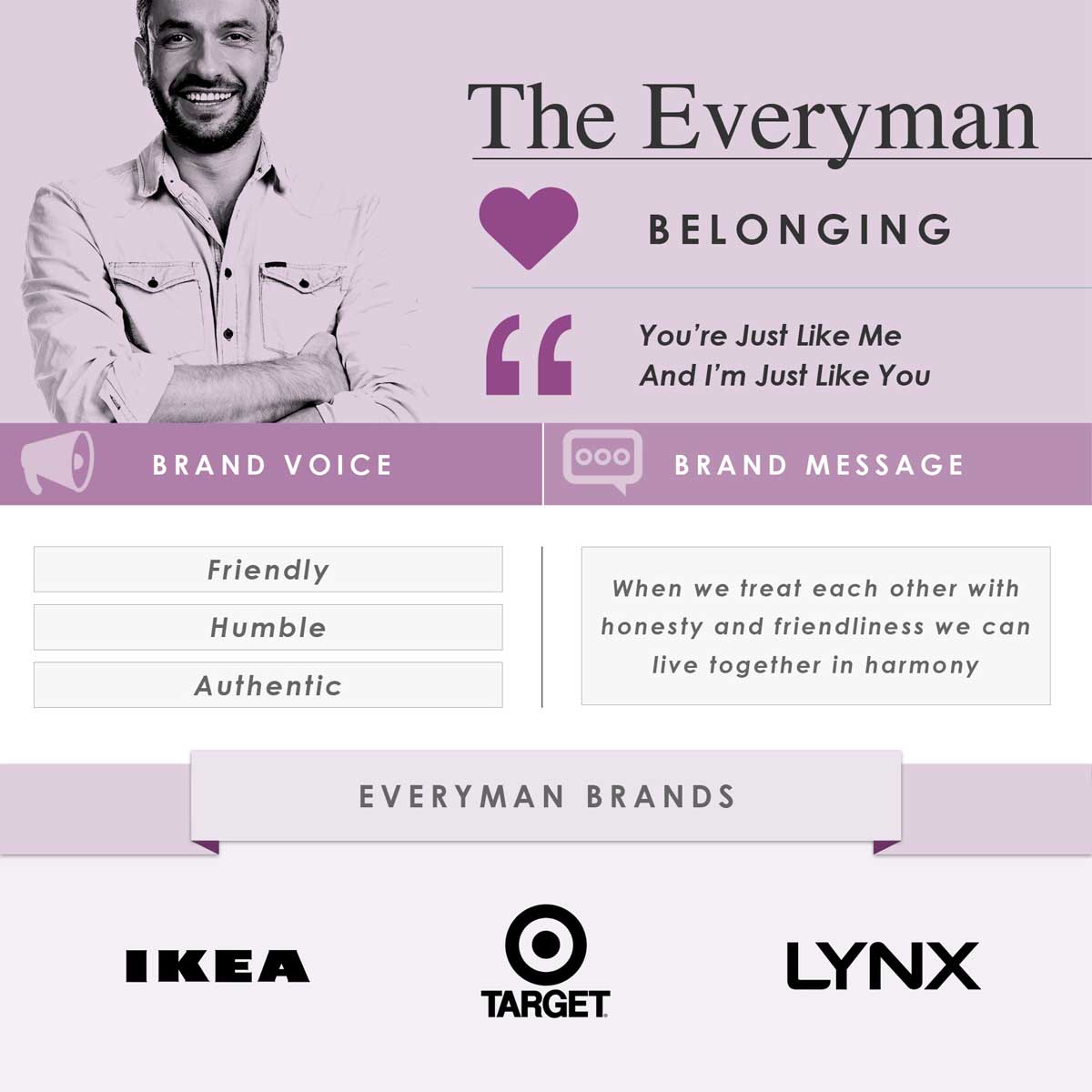
The Everyman Personality
The Everyman above all wants simply to belong. They tend to blend into society as ‘everybody” and don’t like to stand out in the crowd. They’re friendly and easy to talk without being overly funny or overly rude or overly loud.
They lend their trust easily though they fear being rejected. They are relatively positive and strive to fit into the group. They tend to have a liking for most things without being overly passionate about one. The Everyman can be quite liked but can also be easily forgotten.
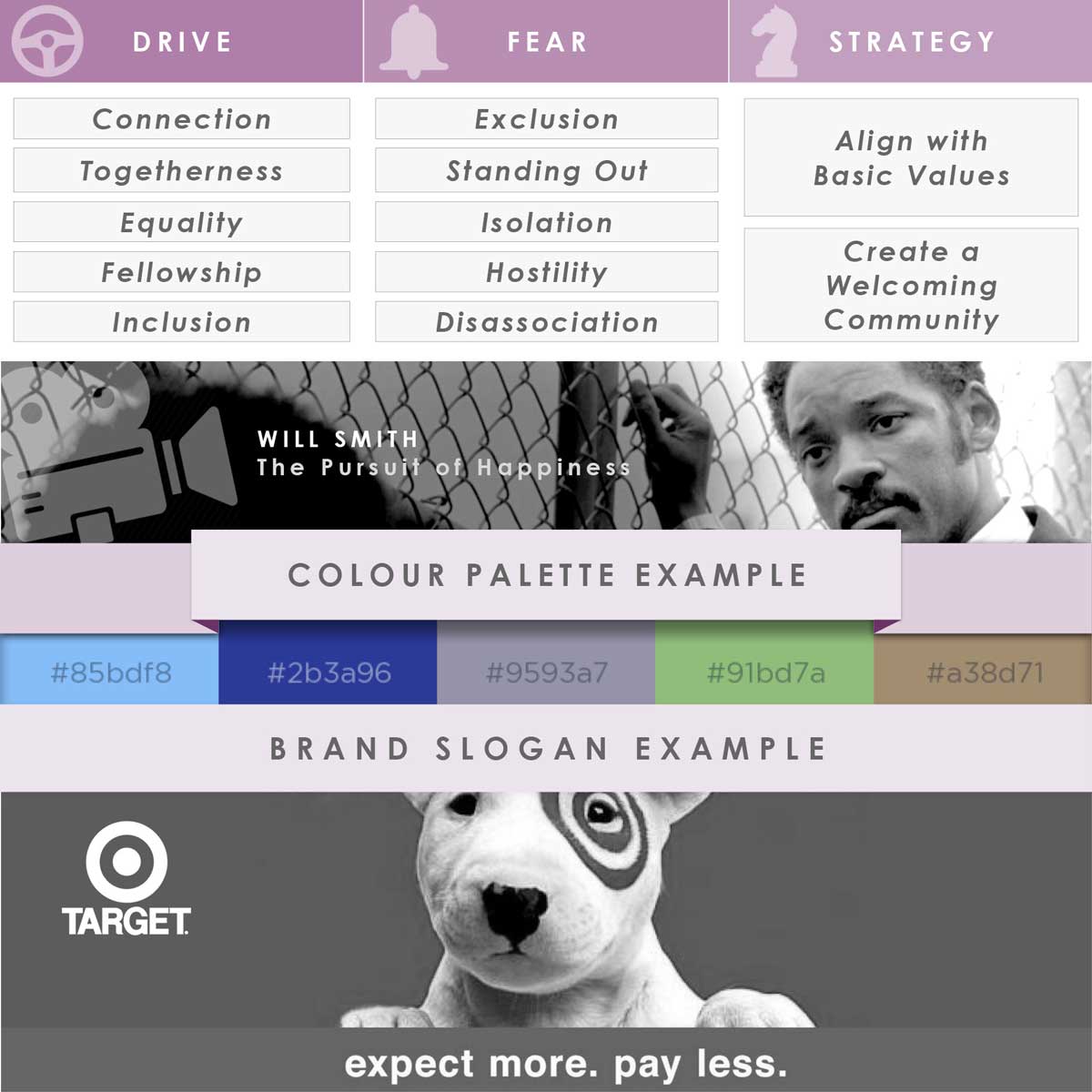
The Everyman Connection Strategy
To appeal to an Everyman you need to make them feel a sense of belonging. Brands that revolve around everyday activities might use this archetype with the message that it’s ok to be normal.
Home or family life brands fit this archetype perfectly while elitist positioning or “we’re better” messaging would be a turn-off. Appealing to an Everyman requires honest, humble, friendly and down to earth communication that doesn’t exclude.
Common Industries: Home / Family Life, Everyday Apparel, Comfort Foods, Automobile (Family / Everyday)
The Everyman Brand In Action – The Gap
The Caregiver Archetype
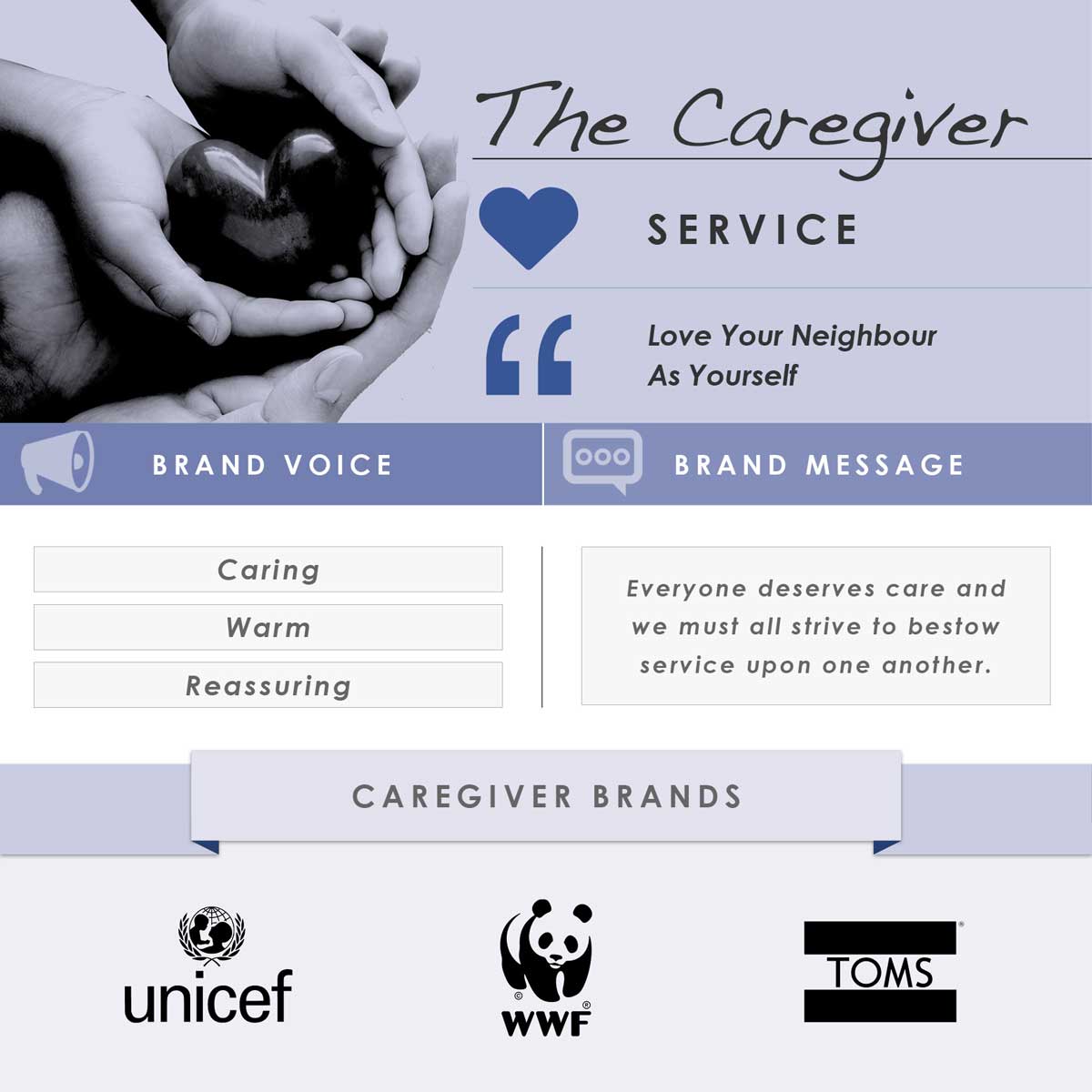
The Caregiver Personality
The Caregiver is a selfless personality who is driven by the desire to protect and care for others, especially those in need. They are often maternity figures and take those who are in need of care, under their wing until they are stronger to take care of themselves.
This personality is personified perfectly by the nursing profession and though they like their effort to be recognised don’t like being patronised. Caregivers are not just reactive, they are also preventative and tend to be in and around an event of harm, before or after.
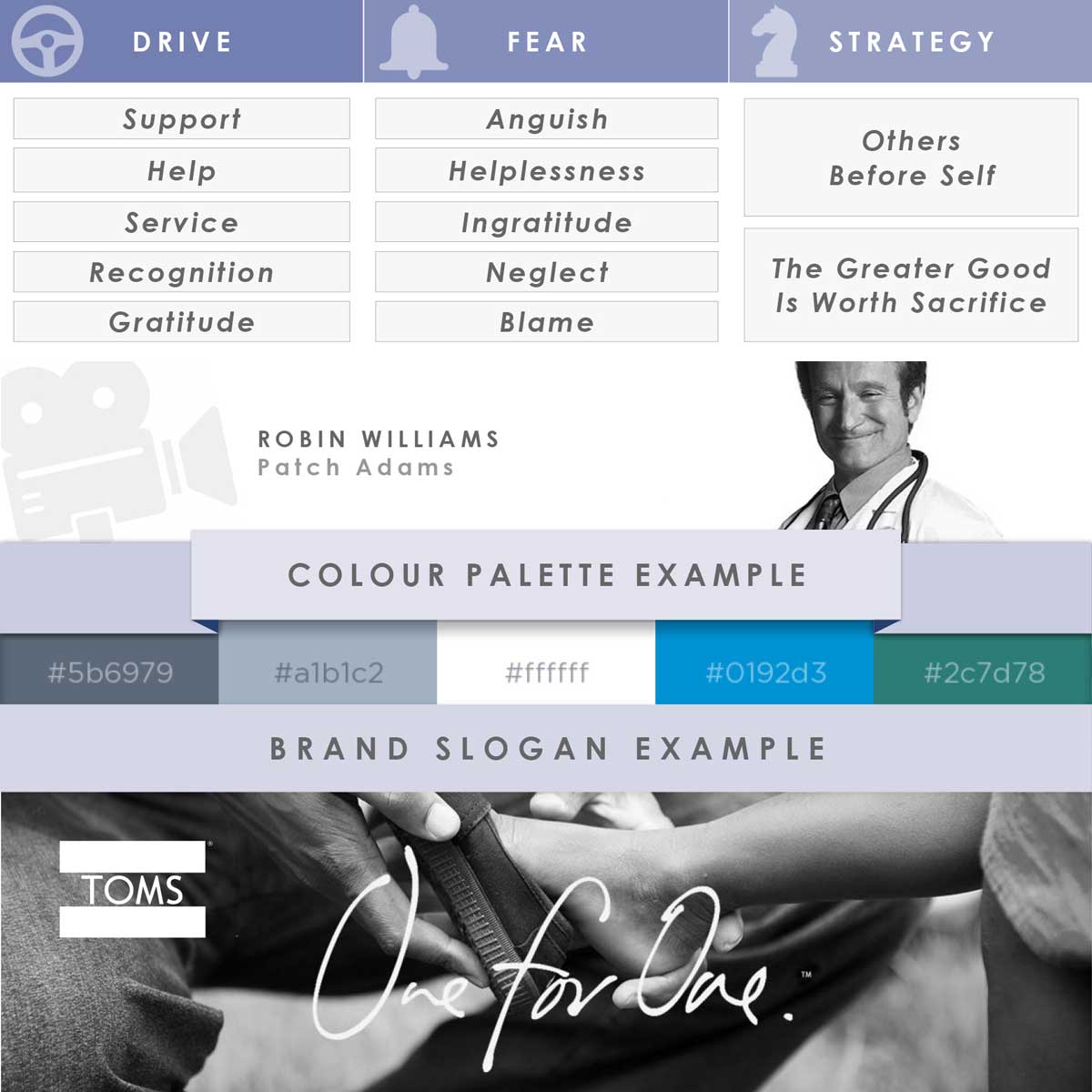
The Caregiver Branding Strategy
The Caregiver archetype is a perfect fit for brands that help those in need. The people such brands help are often vulnerable and sensitive and require a soft touch. Warm, thoughtful, generous and motherly approach offers a feeling of safety that will appeal to their needs.
A Caregiver brands aim is to make their customers feel secure, protected and cared for. Caregiver brands may need to appeal to wider audiences as they often require external input in order provide care for those in need. In such a case, educational and conscience evoking messages may be the key.
Common Industries: Health & Aged Care, Hospitals, Non-Profits, Education
The Caregiver Brand In Action – Unicef
The Ruler Archetype
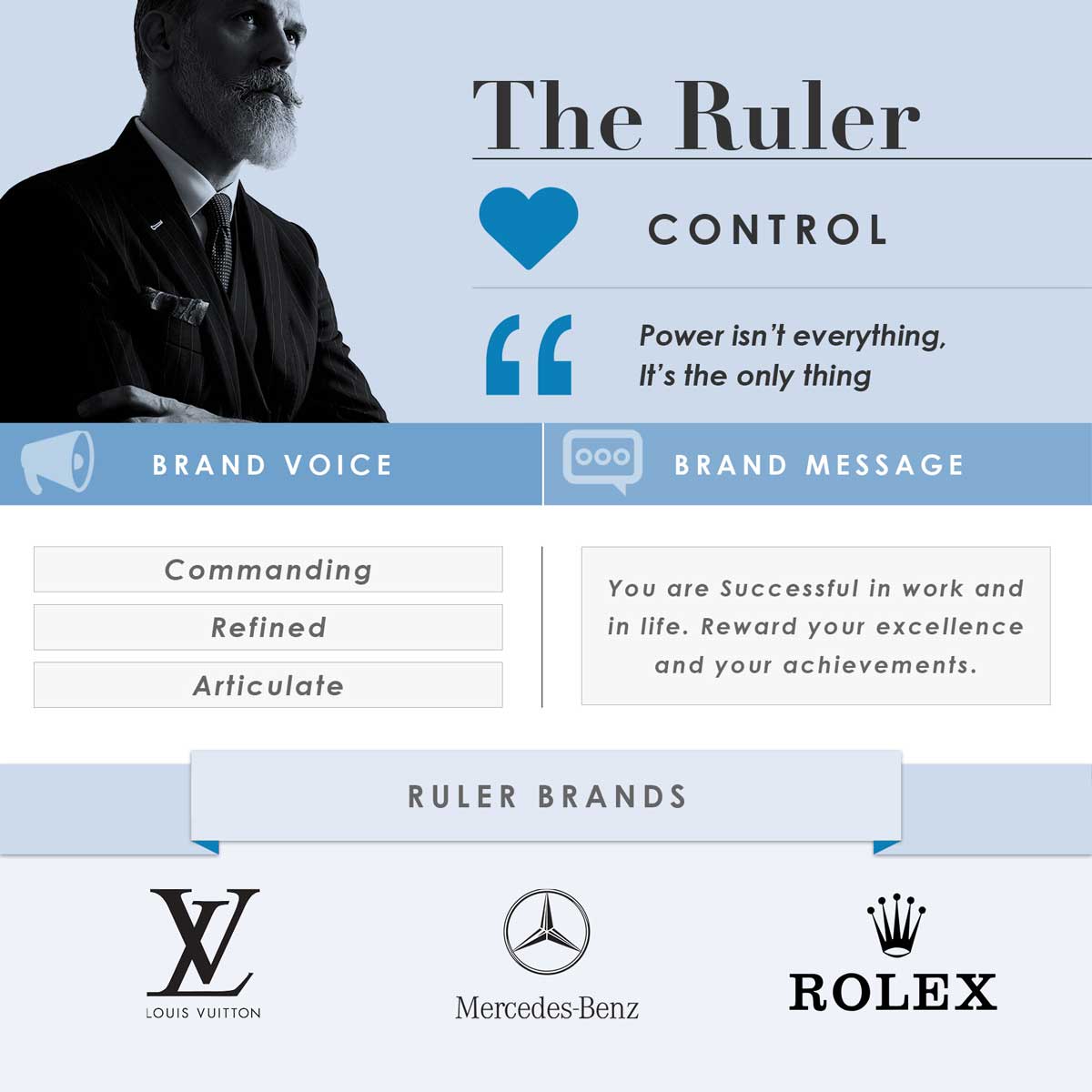
The Ruler Personality
The Ruler desires control above all else and is a dominant personality. They are authoritative in their communication and in their actions and carry a sense of intimidation. Their goal is for prosperity and success and for that prosperity to trickle down to those that are loyal to his rule. They are confident, responsible and in control of their lives and expect the same from others. Rulers see themselves at the top of the food chain and aggressively defend that position.
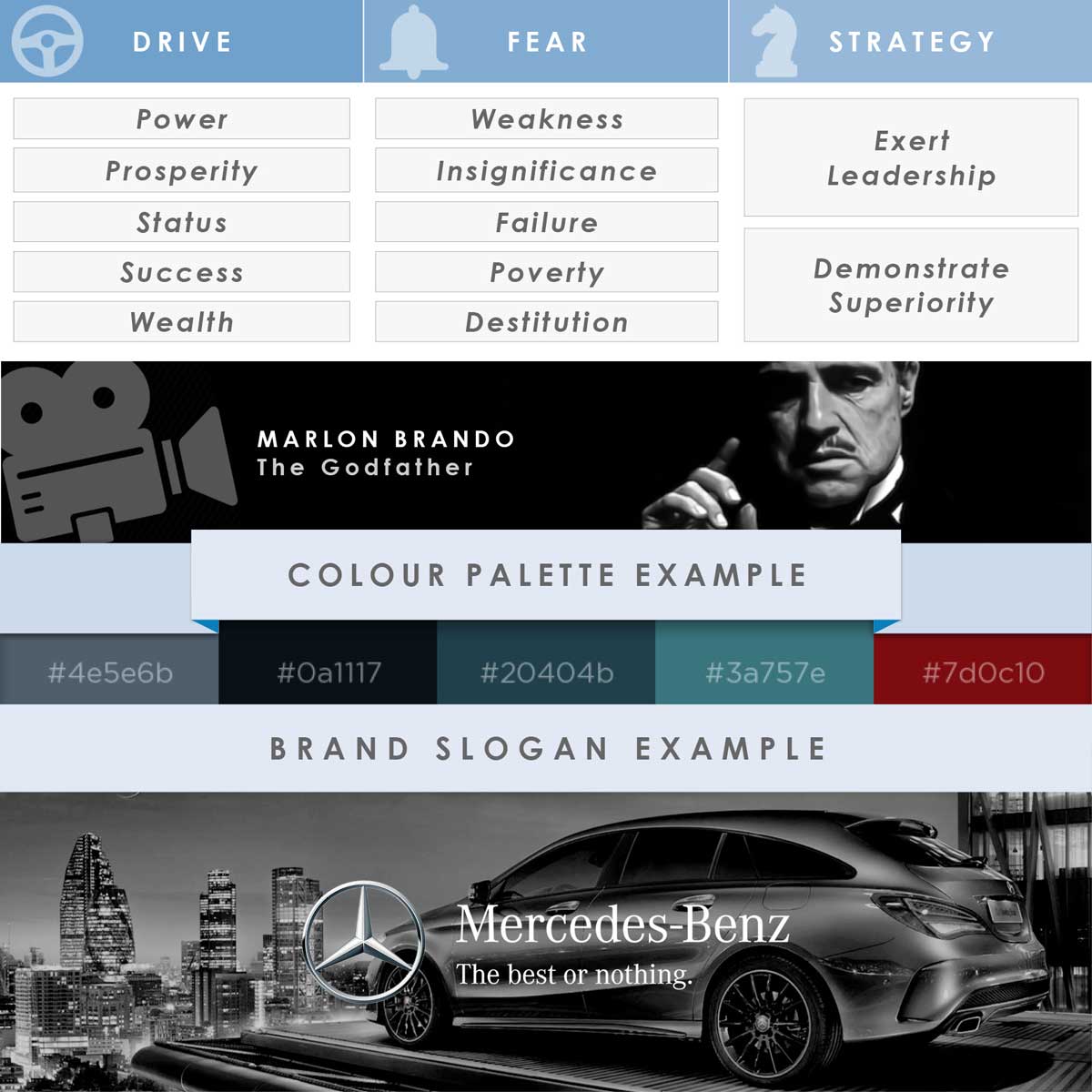
The Ruler Branding Strategy
To appeal to a Ruler you must re-affirm their sense of power, control and respect. Rulers want to feel a sense of superiority. That they are part of an exclusive V.I.P. club. Appealing to the masses will not get the Rulers attention and would more likely turn them off. Ruler brands must provide their customers with a sense re-affirmation that they are at the top of the ladder of success and are part of an exclusive club.
Common Industries: Automotive (Luxury), Watch Manufacturers, Hotels, Formal Wear Apparel, (Any Brands Providing Luxury or High Quality)
The Ruler Brand In Action – Mercedes-Benz
The Creator Archetype
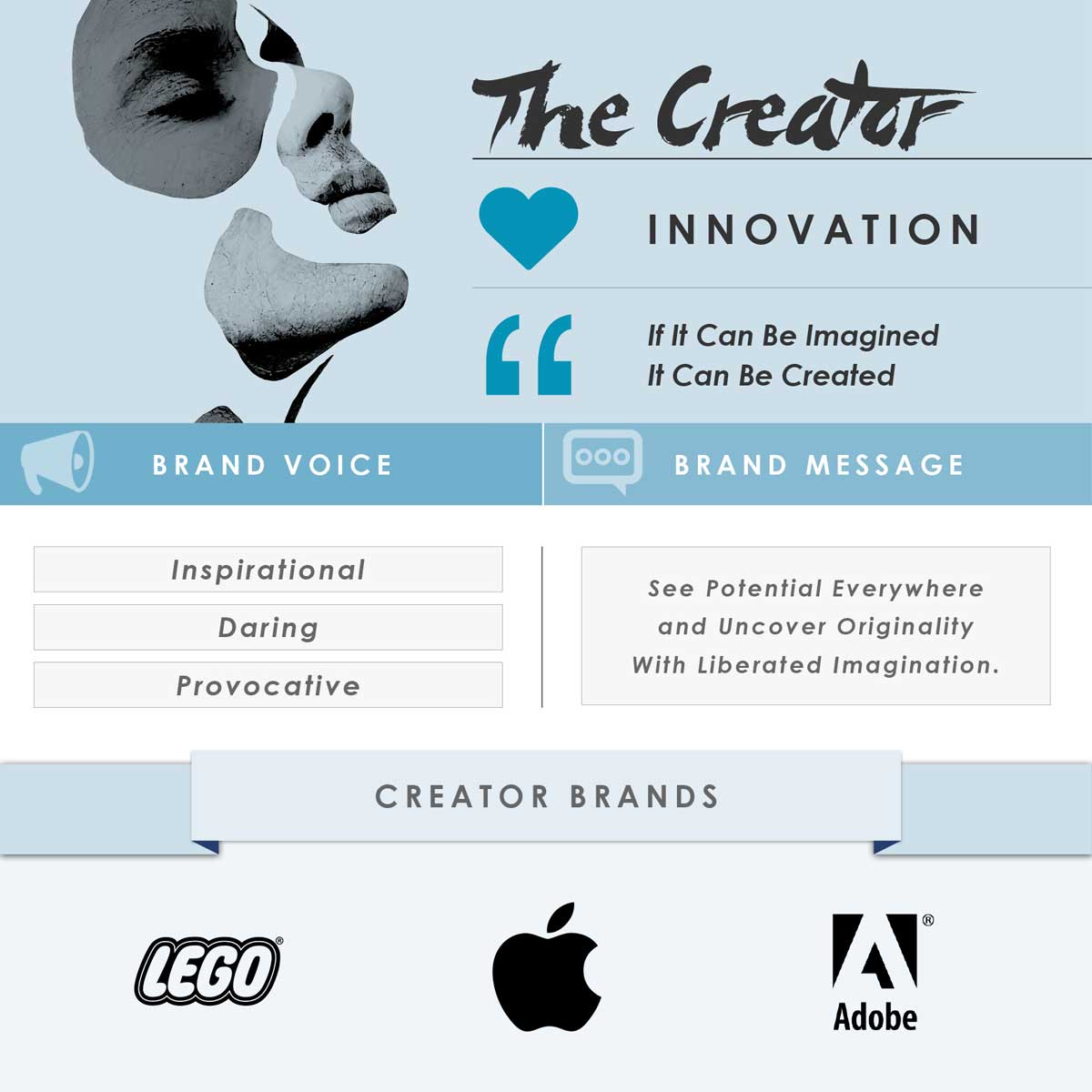
The Creator Personality
The Creator has a desire to create something new and exceptional, that wasn’t previously there, and has enduring value. They need to express themselves with their individual talent and strive to bring their vision to life through that expression. Creators believe that if you imagine it, it can be created but are often stifled by their own desire for perfection.
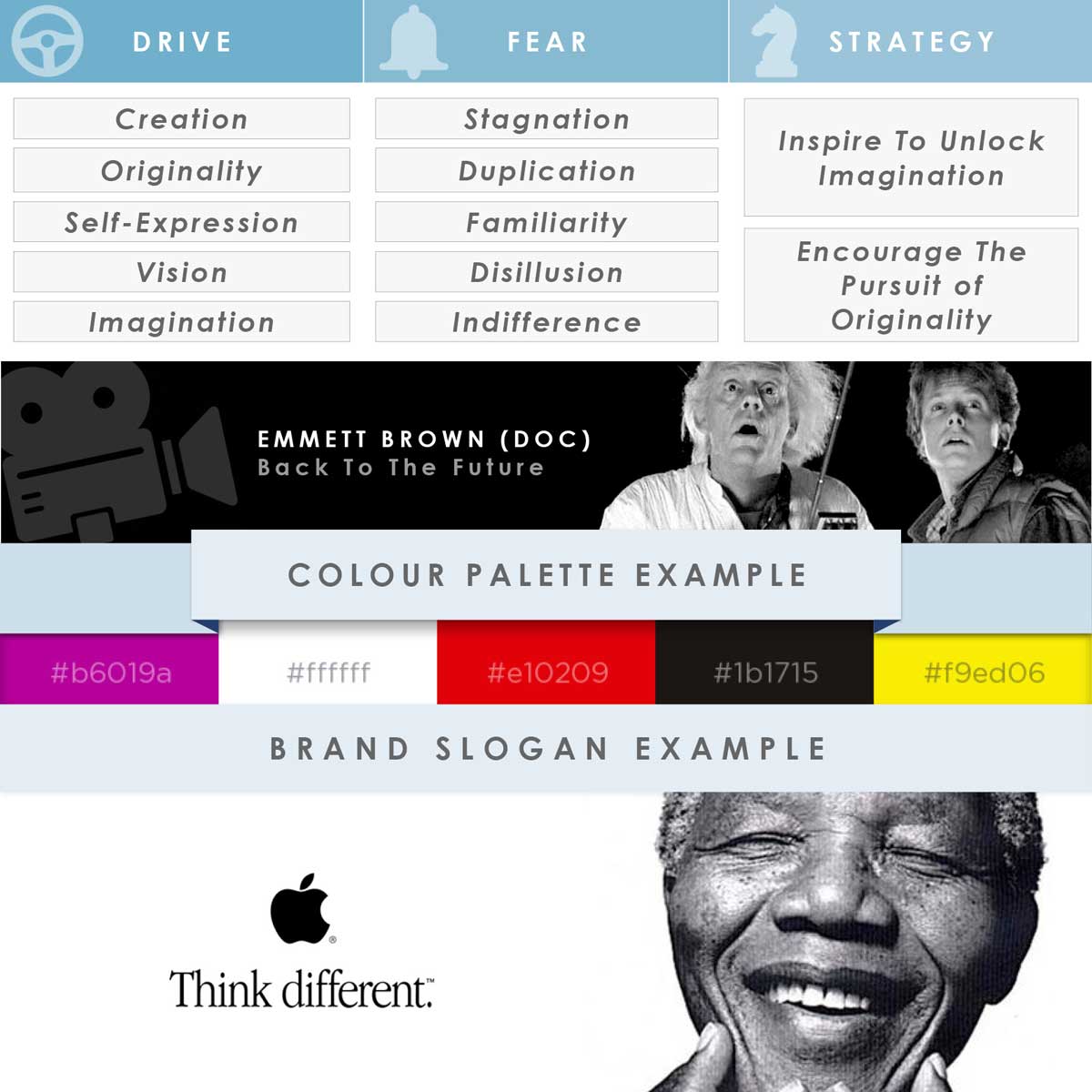
The Creator Branding Strategy
To appeal to a creator you must celebrate the creative process while inspiring self-expression. Brands that provide the means or tools to express themselves creatively with freedom of choices would be well positioned with the Creator Archetype. Their communication should stir the desire for the creative process and inspire their customers to express their nature to the best of their ability. Creator brands leverage their audiences’ imagination and their desire to create and innovate.
Common Industries; Design, Arts, Information Technology, Marketing, Writing
The Creator Brand In Action – Lego
The Innocent Archetype
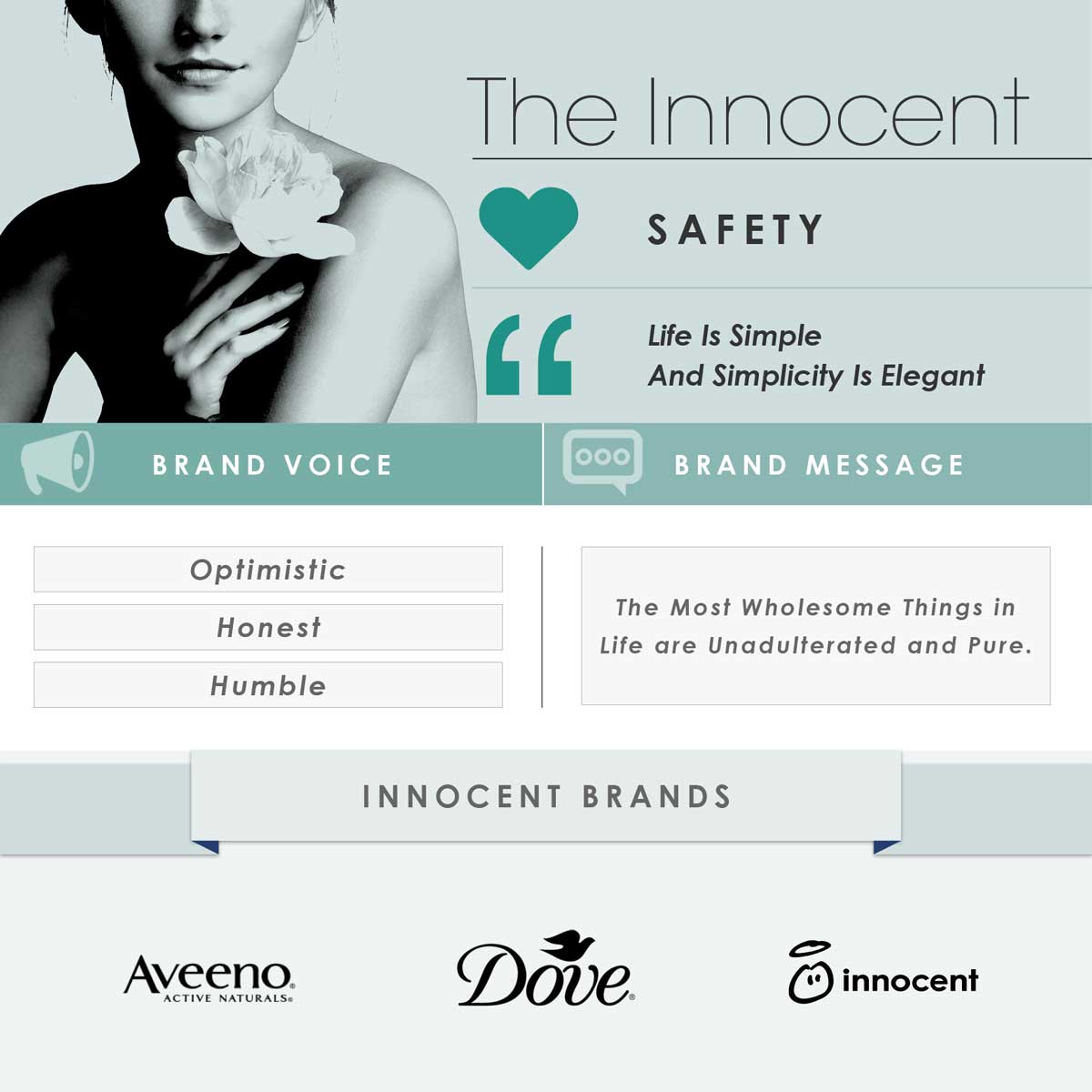
The Innocent Personality
The innocent is a positive personality with an optimistic outlook on life. They crave safety but ultimately, they want themselves and everyone else to be happy.
They are honest and pure and have no ill-will towards anybody. They don’t hold grudges and believe everyone has the divine right to be who they truly are.
They see beauty in everyone and have a knack to see inner beauty that others don’t.
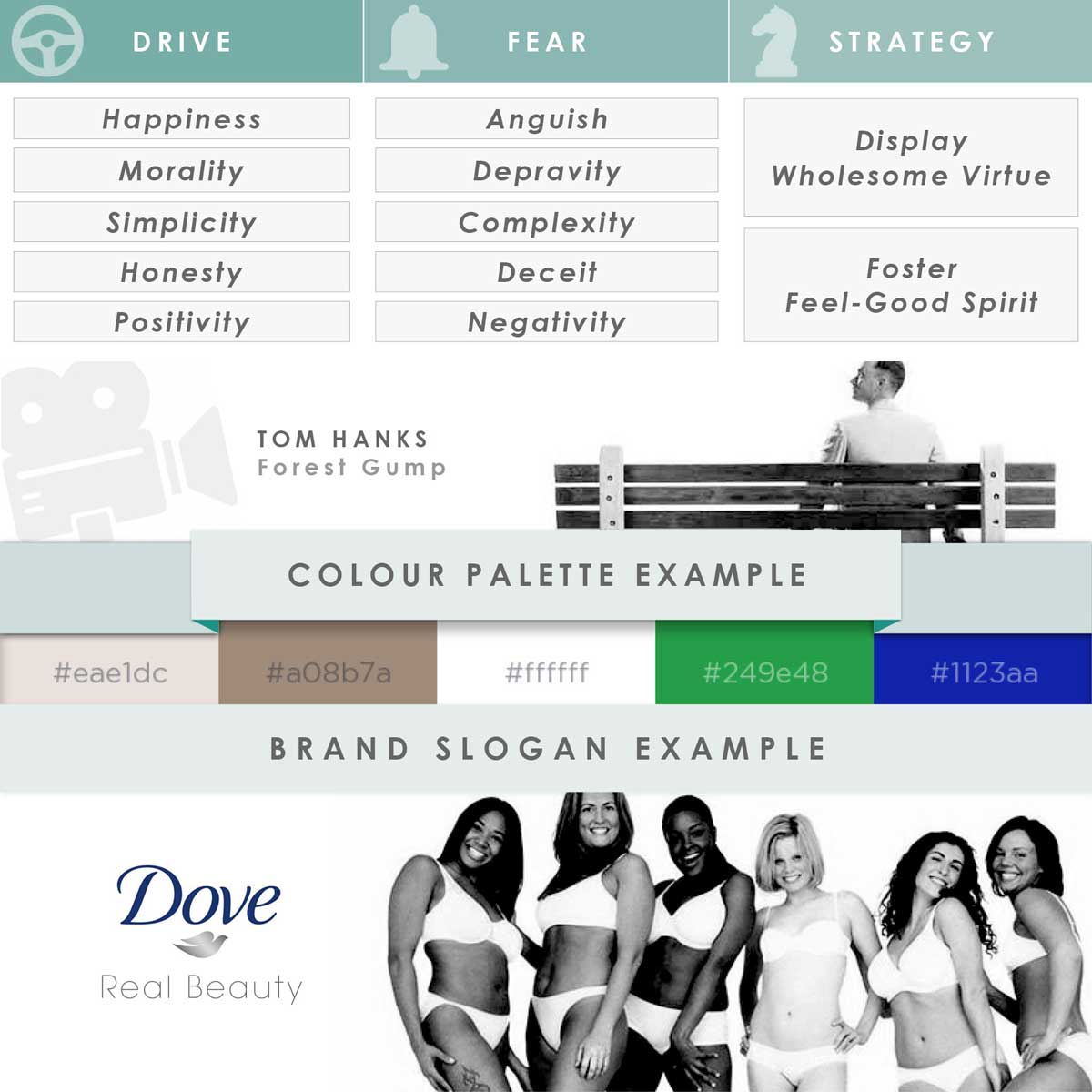
The Innocent Branding Strategy
To appeal to an innocent, you need to earn their trust with simple, honest and most importantly, positive communication. Negative or guilt based communication is a complete turnoff. They need to associate your brand with safety and will feel a connection when their inner beauty is recognised.
Common Industries: Organic, Cleaning, Beauty & Skin Products, Fresh Food, (Anything you put in or on the body)
The Innocent Brand In Action – Dove
The Sage Archetype
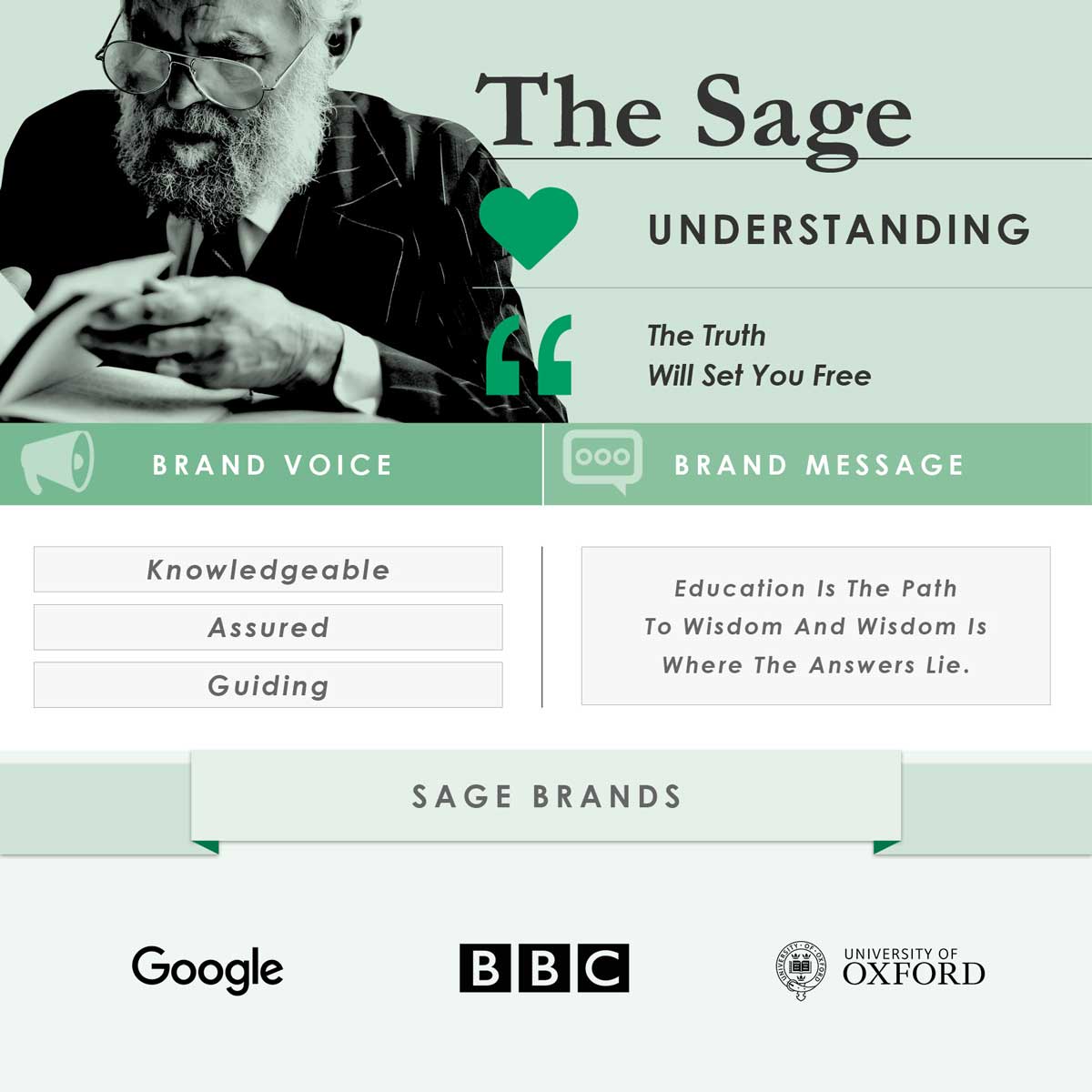
The Sage Personality
The Sage is a seeker of truth, knowledge and wisdom. Their drive comes from the desire to not only understand the world, but to then share that understanding with others. They are life-long learners and enjoy expressing their knowledge with philosophical conversations. They are more likely to pass on their wisdom to someone who can use it to change the world, rather than change the world with it themselves.
The Sage Branding Strategy
To appeal to a sage you need to pay homage to their intelligence as you communicate. Higher level vocabulary with layered or philosophical meaning will be acknowledged and appreciated while over simplified or dumbed down messages will not. They expect factual and well-researched information, which should be watertight to avoid challenges.
Common Industries: Media and News Networks, Schools and Universities, Educational Businesses, Consultancies, Search Engine (Google & Bing)
The Sage Brand In Action – Google
The Explorer Archetype
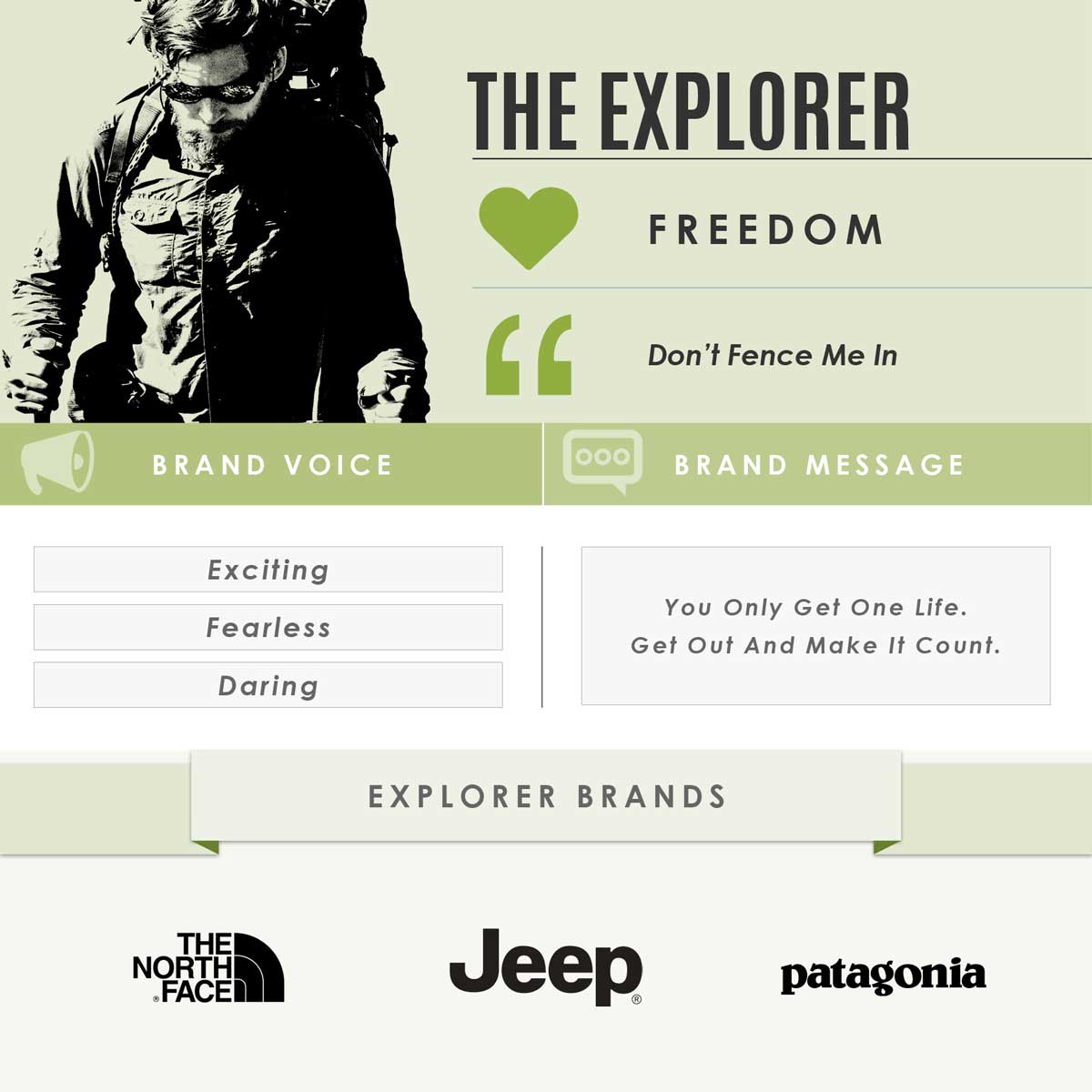
The Explorer Personality
The explorer has a palpable inner drive to push themselves outside their comfort and conformity of everyday life; into the rugged environment they feel at home in. They are brave, adventurous and love a challenge. The challenges are more about understanding themselves more than proving to others and they are on an everlasting journey of discovery.
The Explorer Branding Strategy
To appeal to an explorer, you need to challenge them. Challenging the confines of modern life will also allow you to resonate with them quickly. You should promote the outdoors and the unknown as the land of the free and challenge them to explore it, with your brand of course. Modern society is the common enemy in which many explorers live. A stand against such conforms can go a long way to resonating with the explorer and evoking their desires.
Common Industries: Outdoor Equipment, Extreme Sports, Adventure Travel, Automotive
The Explorer Brand In Action – The North Face
So there we have 12 Brand Archetypes. Now we need to create a strategy and decide which one do you apply to your brand. This is a tricky one as we need to differentiate ourselves as a brand but we don’t want to sound as our competitor.
As you read above I mentioned Common Industries, so an industry will have a typical personality that you would expect. For example, the healthcare sector would be The Caregiver as an example, not an Outlaw.
The key to differentiation is to create an Archetypal Mix and your brand story.
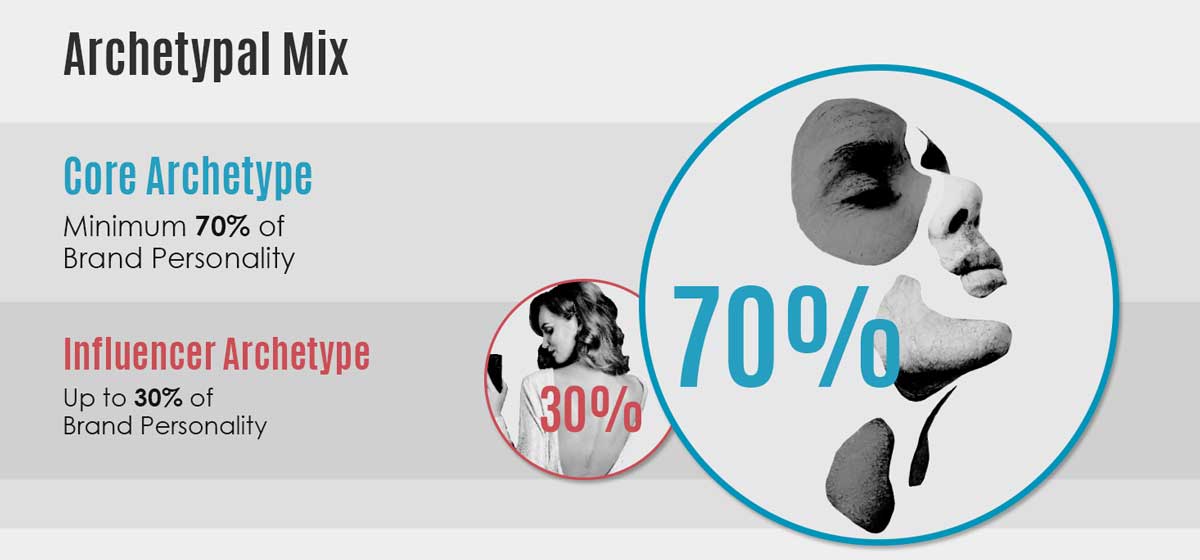
You need to have your core archetype that will represent a minimum of 70% of your brand personality and 30% is your influencer archetype. If you have anything less than 70% you will struggle to connect with your audience through familiarity.
The key is to get creative with the other 30% as you will need to differentiate. That’s where your brand story comes in and your creative 30%. You can go against the grain in your industry with your core archetype (except Caregiver in the Health Space) you can really create a brand that stands out.
The goal is to differentiate not blend in. If you are going to jump into a flock of flamingos with pink feathers then we won’t be able to see you will we?
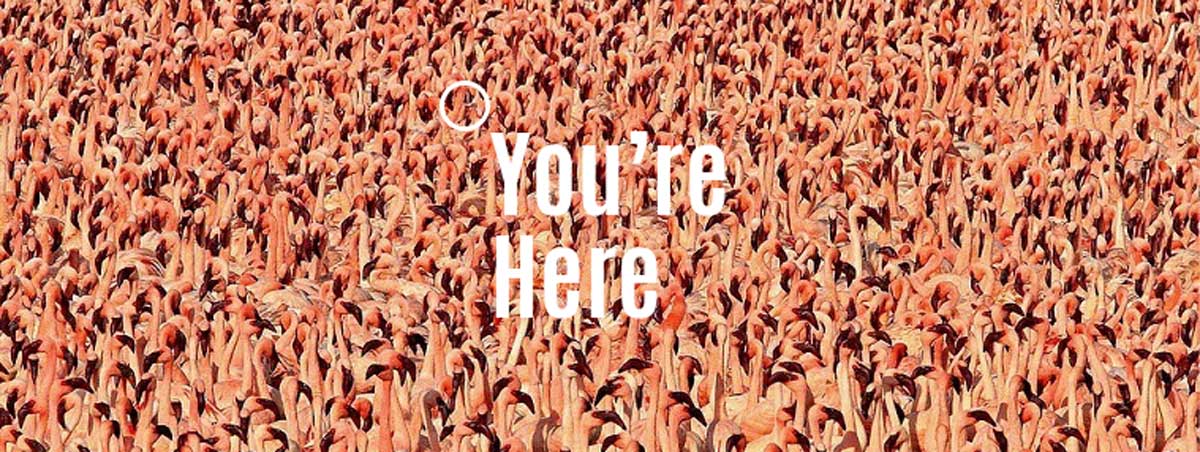
Evoke Your Customers’ Desires
The goal is to identify the desire that you want your brand to evoke and use that desire to define your personality.
So before defining your archetype based purely on your audiences’ personality, consider the primary motivation and the desire you want your archetype to evoke, and develop your brand archetype with that desire at the core. Emotion in branding, as always, is the key.
Brand archetypes speak to your customer’s primary motivations which are often emotionally charged.
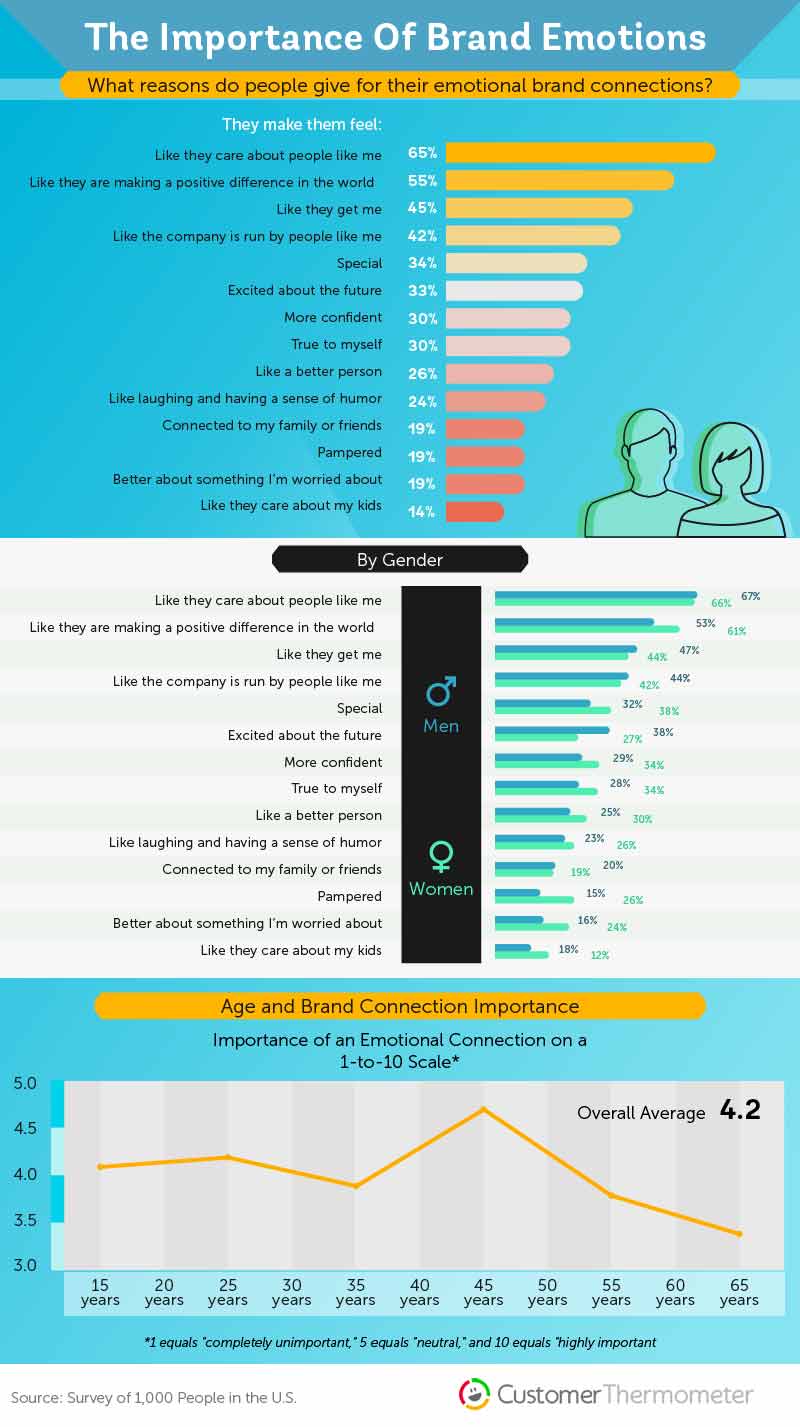
Knowing what you want to mean to your audience is key to taking that position in their mind. Here are some of the most common positional approaches.
- We are the same:
Your personality reassures your audience that they are the same as you. You provide a sense of belonging and togetherness.
- You can be me:
Your personality represents everything your audience aspires to be. Through the alignment of your brand your audience feel like they have arrived at their idea of success.
- I can guide you:
Your personality represents safety, like a lighthouse in a stormy sea. You need to acknowledge the predicament but reassure them you know the path to safety. You are trustworthy and steadfast.
- You can be great:
Your personality inspires your audience to believe in themselves so they can achieve what they want in life. Your communication and personality is motivating.
Then the question becomes how do you apply all this.
Once you have your Archetype in place, you need to flesh it out before applying it to your brand visuals and communication.
- Using the characteristics of your brand archetype, define its opinions on issues related to your market and the wider industry.
- Using keywords, identify its attitude towards life.
- Adopt a tone of voice and writing style that captures these opinions and attitudes.
- Identify the vocabulary that your brand will use keeping the desires your brand is evoking in mind.
- Expand your vocabulary with synonyms and capture this in your brand guidelines.
- Adapt your brand visuals, colours, typography and images to represent this personality visually.
- Apply your vocabulary, opinions, attitudes and tone of voice to all of your brand communication.
Remember, as with a story, the more detail there is in your brand personality, the more vivid and memorable it will be.
Develop your personality on an ongoing basis to ensure it remains in line with who your audience is and the desires it is working to evoke.
When your brand look, feel, tone, attitude, opinions and vocabulary are aligned and are all working together to evoke the desires it satisfies, you will have a brand with a humanistic and memorable personality that your audience will find easy to care for.
Once you define your character, then we start with your story. But that will be another article. So if you want to learn more, you can sign up to my Thoughtful Thursday Letter were I send ideas and thoughts on brand purpose and how we can make a positive change in our society.
In the meantime, if you have any questions or need help, you can always email me at [email protected] or comment below.


